Discovery
- ️Thu Aug 30 1984

Home - Search - Browse - Alphabetic Index: 0- 1- 2- 3- 4- 5- 6- 7- 8- 9
A- B- C- D- E- F- G- H- I- J- K- L- M- N- O- P- Q- R- S- T- U- V- W- X- Y- Z
Discovery
Part of Shuttle
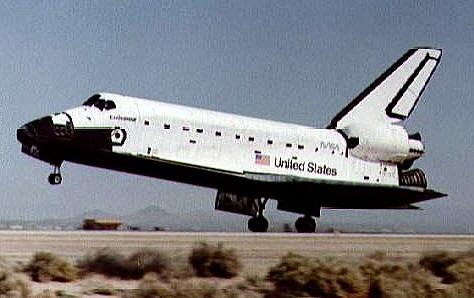
Shuttle Landing
Credit: NASA
American manned spaceplane. merican manned spaceplane.
AKA: OV-103. Status: Operational 1984. First Launch: 1984-08-30. Last Launch: 2011-02-24. Number: 39 . Payload: 24,990 kg (55,090 lb). Thrust: 53.37 kN (11,997 lbf). Gross mass: 116,884 kg (257,685 lb). Unfuelled mass: 104,472 kg (230,321 lb). Specific impulse: 316 s. Height: 37.24 m (122.17 ft). Span: 23.79 m (78.05 ft).
Discovery, the third orbiter to become operational at Kennedy Space Center, was named after one of two ships used by the British explorer James Cook in the 1770s during voyages in the South Pacific that led to the discovery of the Hawaiian Islands. Empty Weight was 68,670 kg at rollout and 77,550 kg with main engines installed.
Discovery benefited from lessons learned in the construction and testing of Enterprise, Columbia and Challenger. At rollout, its weight was some 3115 kg less than Columbia. Two orbiters, Challenger and Discovery, were modified at KSC to enable them to carry the Centaur upper stage in the payload bay. These modifications included extra plumbing to load and vent Centaur's cryogenic Lox/LH2 propellants (other IUS/PAM upper stages used solid propellants), and controls on the aft flight deck for loading and monitoring the Centaur stage. No Centaur flight was ever flown. After the loss of Challenger it was decided that the risk was too great to launch a shuttle with a fueled Centaur upper stage in the payload bay.
Construction Milestones
01/29/79 Contract Award
06/28/76 Start structural assembly of Crew Module
11/10/80 Start structural assembly of aft-fuselage
04/30/82 Wings arrive at Palmdale from Grumman
09/03/82 Start of Final Assembly
08/12/83 Completed Final Assembly 10/16/83 Rollout from Palmdale
11/05/83 Overland transport from Palmdale to Edwards
11/09/83 Delivery to Kennedy Space Center
06/02/84 Flight Readiness Firing
08/30/84 First Flight (41-D)
Discovery underwent its first major OMDP-1 overhaul in February 1992. A complete structural inspection was conducted, and 78 modifications were made, including installation of a drag chute. IMDP-2 was conducted from September 1995 to June 1996, and included installation of the ISS airlock/docking system, improved payload bay lighting, 96 major and 87 deferred change and maintenance items.
Crew Size: 8. Orbital Storage: 30 days. Habitable Volume: 71.50 m3. Structure: 30,374 kg (66,963 lb). Heat shield: 12,110 kg (26,690 lb). Reaction Control System: 2,793 kg (6,157 lb). Recovery Equipment: 4,186 kg (9,228 lb). Navigation Equipment: 1,960 kg (4,320 lb). Electrical Equipment: 6,961 kg (15,346 lb). Communications Systems: 674 kg (1,485 lb). Crew Seats and Provisions: 745 kg (1,642 lb). Miscellaneous Contingency: 2,425 kg (5,346 lb). Environmental Control System: 2,487 kg (5,482 lb). RCS Coarse No x Thrust: 38 x 387 N. RCS Fine No x Thrust: 6 x 107 N. RCS specific impulse: 289 sec. RCS total impulse: 9,355 kgf-sec. Spacecraft delta v: 700 m/s (2,290 ft/sec). Electric System: 3,100.00 kWh. Electric System: 14.00 average kW.
Family: Spaceplane, US Rocketplanes. Country: USA. Spacecraft: ISS, Mir. Flights: STS-41-D, STS-51-A, STS-51-C, STS-51-D, STS-51-G, STS-51-I, STS-26, STS-29, STS-33, STS-31, STS-41, STS-39, STS-48, STS-42, STS-53, STS-56, STS-51, STS-60, STS-64, STS-63, STS-70, STS-82, STS-85, STS-91, STS-95, STS-96, STS-103, STS-92, STS-102, STS-105, STS-114, STS-121, STS-116, STS-120, STS-124, STS-119, STS-128, STS-131, STS-133. Launch Vehicles: Space Shuttle. Propellants: N2O4/MMH. Projects: STS. Launch Sites: Cape Canaveral, Cape Canaveral LC39A, Cape Canaveral LC39B. Agency: NASA, North American. Bibliography: 15, 2, 276, 296, 3134, 33, 44, 552, 554, 6, 66, 7, 8.
Photo Gallery
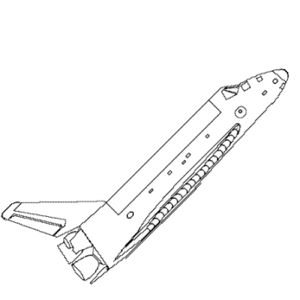 | Shuttle Orbiter Shuttle Orbiter side view Credit: © Mark Wade |
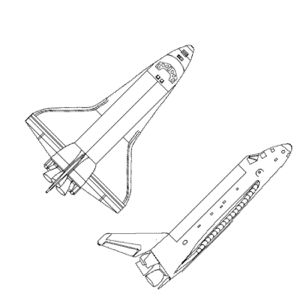 | Shuttle Orbiter Shuttle Orbiter 2 view Credit: © Mark Wade |
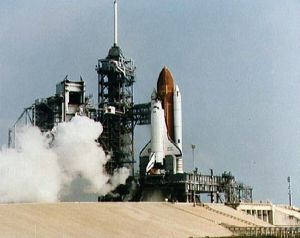 | STS-41-D View of launch of orbiter Discovery on 41-D mission Credit: NASA |
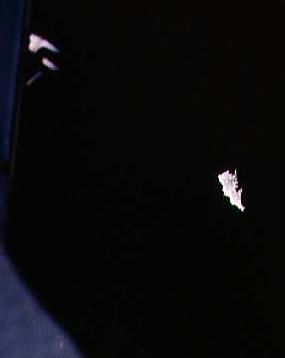 | STS-41-D View of foot restraint strayed from Discovery Credit: NASA |
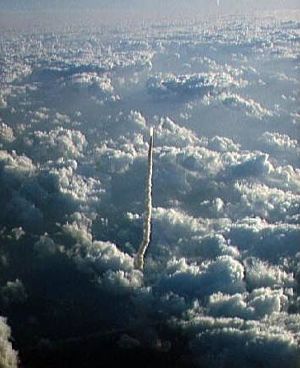 | STS-51-A Aerial view of the launch of STS 51-A shuttle Discovery Credit: NASA |
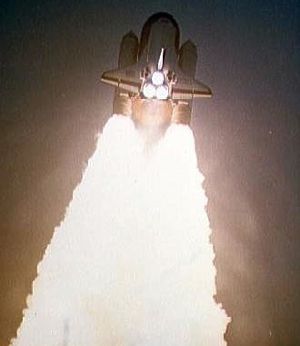 | STS-51-A View of the launch of STS 51-A shuttle Discovery Credit: NASA |
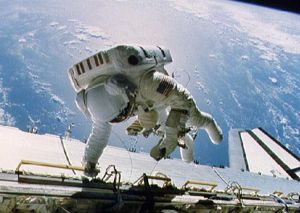 | STS-51-A Astronaut Dale Gardner tethered to Discovery's starboard side. Credit: NASA |
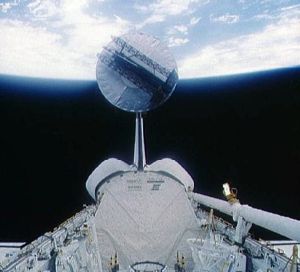 | STS-51-A Syncom IV-1 satellite leaving Discovery's payload bay Credit: NASA |
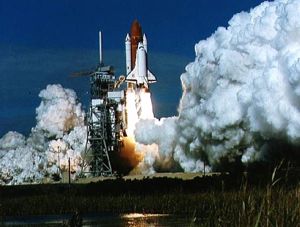 | STS-51-C Launch of Shuttle Discovery and the STS 51-C mission Credit: NASA |
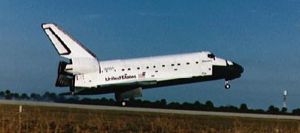 | STS-51-C Landing of the shuttle Discovery at end of STS 51-C mission Credit: NASA |
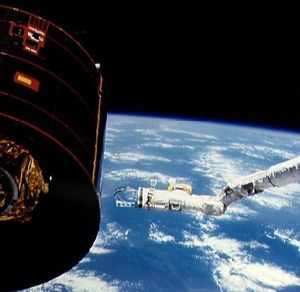 | STS-51-D End effector of the Discovery's RMS with tools moves toward Syncom-IV Credit: NASA |
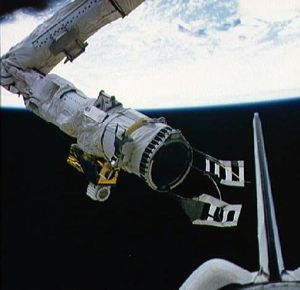 | STS-51-D End effector of the Discovery's RMS with tools attached Credit: NASA |
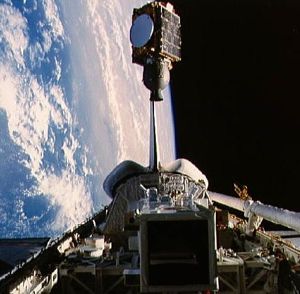 | STS-51-G Arabsat communications satellite deploying from Discovery's payload bay Credit: NASA |
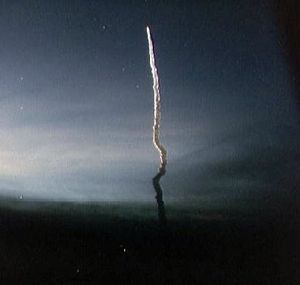 | STS-51-I Aerial view of the launch of Shuttle Discovery STS 51-I mission Credit: NASA |
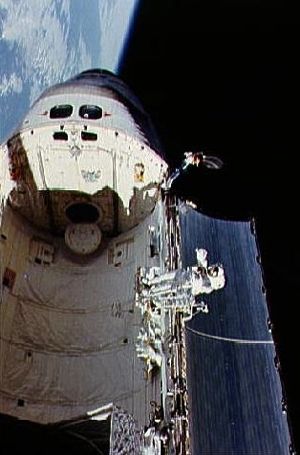 | STS-51-I Astronaut William Fisher anchored to foot restraint on Discovery Credit: NASA |
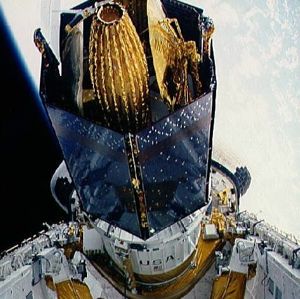 | STS-26 STS-26 Discovery, Orbiter Vehicle (OV) 103, IUS / TDRS-C deployment Credit: NASA |
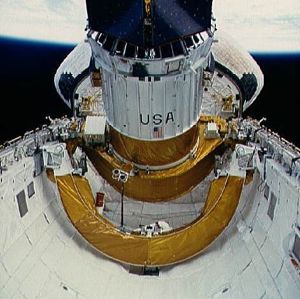 | STS-26 STS-26 Discovery, Orbiter Vehicle (OV) 103, IUS / TDRS-C deployment Credit: NASA |
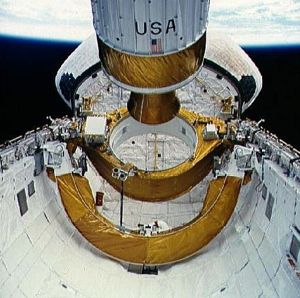 | STS-26 STS-26 Discovery, Orbiter Vehicle (OV) 103, IUS / TDRS-C deployment Credit: NASA |
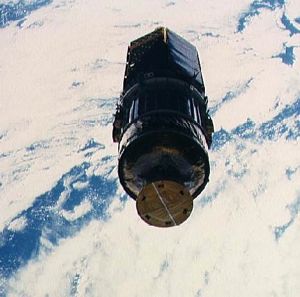 | STS-26 STS-26 Discovery, Orbiter Vehicle (OV) 103, IUS / TDRS-C deployment Credit: NASA |
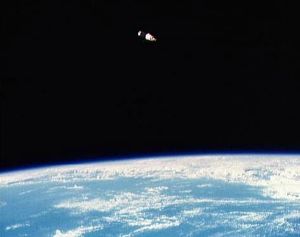 | STS-26 STS-26 Discovery, Orbiter Vehicle (OV) 103, IUS / TDRS-C deployment Credit: NASA |
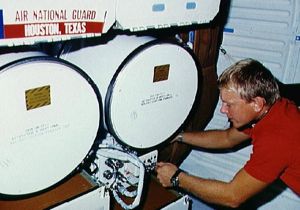 | STS-26 STS-26 MS Nelson adjusts ADSF power cable on Discovery's middeck Credit: NASA |
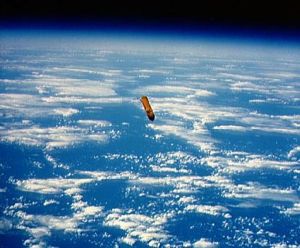 | STS-29 STS-29 Discovery, OV-103, external tank (ET) separation Credit: NASA |
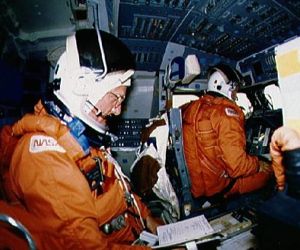 | STS-29 STS-29 Discovery, OV-103, crew on flight deck prepares for re-entry Credit: NASA |
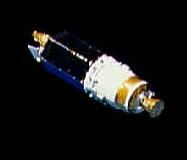 | STS-29 STS-29 IUS with TDRS-D after deployment from Discovery, OV-103 Credit: NASA |
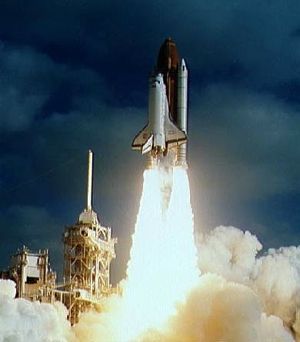 | STS-31 STS-31 Discovery, Orbiter Vehicle (OV) 103, lifts off from KSC LC Pad 39B Credit: NASA |
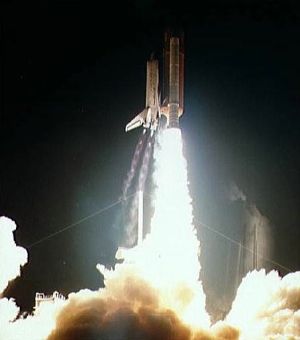 | STS-33 STS-33 Discovery, OV-103, early morning lift-off from KSC LC Pad 39B Credit: NASA |
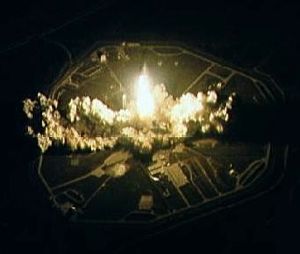 | STS-33 Aerial view of STS-33 Discovery, OV-103, lifting off from KSC LC Pad 39B Credit: NASA |
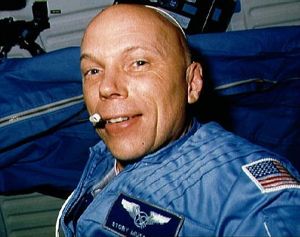 | STS-33 STS-33 MS Musgrave, wearing headset, poses on Discovery's, OV-103's, middeck Credit: NASA |
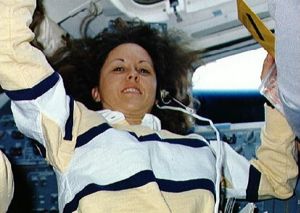 | STS-33 STS-33 MS Thornton on Discovery's, OV-103's, aft flight deck Credit: NASA |
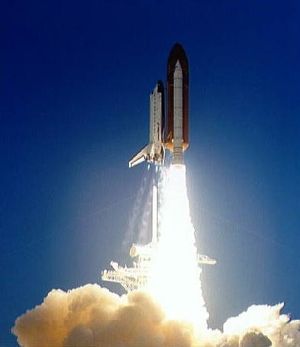 | STS-41 STS-41 Discovery, OV-103, lifts off from KSC Launch Complex (LC) Pad 39 Credit: NASA |
1979 August 1 - . LV Family: Shuttle. Launch Vehicle: Space Shuttle.
- Start long-lead fabrication crew module, Discovery - . Nation: USA. Program: STS. Class: Manned. Type: Manned spaceplane. Spacecraft Bus: Shuttle. Spacecraft: Discovery.
1979 August 27 - .
- Start long-lead fabrication crew module, Discovery - . Nation: USA. Program: STS. Class: Manned. Type: Manned spaceplane. Spacecraft Bus: Shuttle. Spacecraft: Discovery.
1984 June 26 - . Launch Site: Cape Canaveral. Launch Complex: Cape Canaveral LC39A. LV Family: Shuttle. Launch Vehicle: Space Shuttle.
- Shuttle Discovery Pad Abort - . Nation: USA. Program: STS. Flight: STS-41-D. Spacecraft Bus: Shuttle. Spacecraft: Discovery. The countdown for the second launch attempt for Discovery's maiden flight ended at T- 4 seconds when the orbiter's computers detected a sluggish valve in main engine #3. The main engine was replaced and Discovery was finally launched on August 30, 1984..
1984 August - .
- STS-41-F (cancelled) - . Crew: Bobko, Griggs, Hoffman, Seddon, Williams, Donald. Payload: Communications satellites. Nation: USA. Related Persons: Bobko, Griggs, Hoffman, Seddon, Williams, Donald. Program: STS. Flight: STS-41-F. Spacecraft Bus: Shuttle. Spacecraft: Discovery. Planned shuttle mission for deployment of commercial communications satellites. Cancelled due to payload delays..
1984 August 30 - . 12:41 GMT - . Launch Site: Cape Canaveral. Launch Complex: Cape Canaveral LC39A. Launch Platform: MLP2. LV Family: Shuttle. Launch Vehicle: Space Shuttle.
- STS-41-D - .
Call Sign: Discovery. Crew: Coats,
Hartsfield,
Hawley,
Mullane,
Resnik,
Walker.
Payload: Discovery F01 / SBS 4[PAM-D] / Telstar 302[PAM-D]. Mass: 21,552 kg (47,514 lb). Nation: USA.
Related Persons: Coats,
Hartsfield,
Hawley,
Mullane,
Resnik,
Walker.
Agency: NASA Houston.
Program: STS.
Class: Manned.
Type: Manned spaceplane. Flight: STS-41-D.
Spacecraft Bus: Shuttle.
Spacecraft: Discovery.
Duration: 6.04 days. Decay Date: 1984-09-05 . USAF Sat Cat: 15234 . COSPAR: 1984-093A. Apogee: 307 km (190 mi). Perigee: 300 km (180 mi). Inclination: 28.50 deg. Period: 90.60 min.
Manned six crew. First flight of space shuttle Discovery; deployed SBS 4, Leasat 1, Telstar 3C. Payloads: Satellite Business System (SBS)-D commu-nications satellite with Payload Assist Module (PAM)-D deployment, Syncom IV-2 communica-tions satellite with its unique stage deployment, Telstar (American Telephone and Telegraph) 3-C with PAM-D deployment, Office of Aeronautics and Space Technology (OAST)-1 experiments. Deployment and restowing of large solar array. Continuous Flow Electrophoresis (CFES). IMAX camera.
1984 November 8 - . 12:15 GMT - . Launch Site: Cape Canaveral. Launch Complex: Cape Canaveral LC39A. Launch Platform: MLP2. LV Family: Shuttle. Launch Vehicle: Space Shuttle.
- STS-51-A - .
Call Sign: Discovery. Crew: Allen,
Fisher,
Gardner,
Hauck,
Walker, Dave.
Payload: Discovery F02 / PLT. Mass: 20,550 kg (45,300 lb). Nation: USA.
Related Persons: Allen,
Fisher,
Gardner,
Hauck,
Walker, Dave.
Agency: NASA Houston.
Program: STS.
Class: Manned.
Type: Manned spaceplane. Flight: STS-51-A.
Spacecraft Bus: Shuttle.
Spacecraft: Discovery.
Duration: 7.99 days. Decay Date: 1984-11-16 . USAF Sat Cat: 15382 . COSPAR: 1984-113A. Apogee: 297 km (184 mi). Perigee: 289 km (179 mi). Inclination: 28.40 deg. Period: 90.40 min.
Manned five crew. First retrieval of two satellites (PALAPA B-2 and WESTAR Vl) for return to earth. Deployed Anik D2, Leasat 2; recovered Westar 6, Palapa B2. Payloads: Telesat (Canada communications satellite)-H with Payload Assist Module (PAM)-D deploy-ment, Syncom IV-1 communications satellite deployment with its unique stage, retrieval of PALAPA B-2 and WESTAR VI communications satellites with PAM-D which failed to ignite on the STS-41-B mission. Manned maneuvering unit (MMU) used for retrieval. Diffusive Mixing of Organic Solutions (DMOS) experiment.
1984 November 12 - . 13:25 GMT - .
- EVA STS-51-A-1 - . Crew: Allen, Gardner. EVA Duration: 0.26 days. Nation: USA. Related Persons: Allen, Gardner. Program: STS. Class: Manned. Type: Manned spaceplane. Flight: STS-51-A. Spacecraft Bus: Shuttle. Spacecraft: Discovery. Retrieved Palapa satellite..
1984 November 14 - .
- EVA STS-51-A-2 - . Crew: Allen, Gardner. EVA Duration: 0.25 days. Nation: USA. Related Persons: Allen, Gardner. Program: STS. Class: Manned. Type: Manned spaceplane. Flight: STS-51-A. Spacecraft Bus: Shuttle. Spacecraft: Discovery. Retrieved Westar satellite..
1985 January 24 - . 19:50 GMT - . Launch Site: Cape Canaveral. Launch Complex: Cape Canaveral LC39A. Launch Platform: MLP1. LV Family: Shuttle. Launch Vehicle: Space Shuttle.
- STS-51-C - .
Call Sign: Discovery. Crew: Buchli,
Mattingly,
Onizuka,
Payton,
Shriver.
Payload: Discovery F03 / Magnum 1 [IUS]. Mass: 116,884 kg (257,685 lb). Nation: USA.
Related Persons: Buchli,
Mattingly,
Onizuka,
Payton,
Shriver.
Agency: NASA Houston.
Program: STS.
Class: Manned.
Type: Manned spaceplane. Flight: STS-51-C.
Spacecraft Bus: Shuttle.
Spacecraft: Discovery.
Duration: 3.06 days. Decay Date: 1985-01-27 . USAF Sat Cat: 15496 . COSPAR: 1985-010A. Apogee: 341 km (211 mi). Perigee: 332 km (206 mi). Inclination: 28.40 deg. Period: 91.30 min.
Manned five crew. Deployed USA 8 (Aquacade ELINT spacecraft). Orbits of Earth: 48. Landed at: Runway 15 at Kennedy Space Center, Florida. Landing Speed: 342 kph. Touchdown miss distance: 839.00 m. Landing Rollout: 2,240.00 m. Payloads: Department of Defence classified payloads.
1985 April - .
- STS-51-AA (cancelled) - . Crew: Creighton, Fabian, Jarvis, Lucid, Nagel, Walker. Backup Crew: Konrad. Nation: USA. Program: STS. Flight: STS-51-AA. Spacecraft Bus: Shuttle. Spacecraft: Discovery. Planned shuttle mission. Cancelled due to payload delays..
1985 April 12 - . 13:59 GMT - . Launch Site: Cape Canaveral. Launch Complex: Cape Canaveral LC39A. Launch Platform: MLP1. LV Family: Shuttle. Launch Vehicle: Space Shuttle.
- STS-51-D - .
Call Sign: Discovery. Crew: Bobko,
Garn,
Griggs,
Hoffman,
Seddon,
Walker,
Williams, Donald.
Payload: Discovery F04 / Anik C1[PAM-D] / Syncom-4 3 /Orbus. Mass: 16,249 kg (35,822 lb). Nation: USA.
Related Persons: Bobko,
Garn,
Griggs,
Hoffman,
Seddon,
Walker,
Williams, Donald.
Agency: NASA Houston.
Program: STS.
Class: Manned.
Type: Manned spaceplane. Flight: STS-51-D.
Spacecraft Bus: Shuttle.
Spacecraft: Discovery.
Duration: 7.00 days. Decay Date: 1985-04-19 . USAF Sat Cat: 15641 . COSPAR: 1985-028A. Apogee: 535 km (332 mi). Perigee: 445 km (276 mi). Inclination: 28.50 deg. Period: 94.40 min.
Manned seven crew. Payloads: Telesat (Canada communications satellite)-I with Payload Assist Module (PAM)-D deployment, Syncom IV-3 communications satellite deploy-ment with its unique stage (unique stage failed to ignite), Continuous Flow Electrophoresis (CFES), Phase Partitioning Experiment (PPE), student experiments, two getaway specials (GAS) Informal science studies (Toys in Space).
1985 April 16 - .
- EVA STS-51-D-1 - . Crew: Griggs, Hoffman. EVA Duration: 0.13 days. Nation: USA. Related Persons: Griggs, Hoffman. Program: STS. Class: Manned. Type: Manned spaceplane. Flight: STS-51-D. Spacecraft Bus: Shuttle. Spacecraft: Discovery. RMS 'Ryswatters' installed..
1985 June 17 - . 11:33 GMT - . Launch Site: Cape Canaveral. Launch Complex: Cape Canaveral LC39A. Launch Platform: MLP1. LV Family: Shuttle. Launch Vehicle: Space Shuttle.
- STS-51-G - .
Call Sign: Discovery. Crew: Al-Saud,
Baudry,
Brandenstein,
Creighton,
Fabian,
Lucid,
Nagel.
Payload: Discovery F05 / Morelos 1[PAM-D] / Telstar 303. Mass: 20,174 kg (44,476 lb). Nation: USA.
Related Persons: Al-Saud,
Baudry,
Brandenstein,
Creighton,
Fabian,
Lucid,
Nagel.
Agency: NASA Houston.
Program: STS.
Class: Manned.
Type: Manned spaceplane. Flight: STS-51-G.
Spacecraft Bus: Shuttle.
Spacecraft: Discovery.
Duration: 7.07 days. Decay Date: 1985-06-24 . USAF Sat Cat: 15823 . COSPAR: 1985-048A. Apogee: 369 km (229 mi). Perigee: 358 km (222 mi). Inclination: 28.50 deg. Period: 91.80 min.
Deployed and retrieved Spartan 1; launched Morelos 1, Arabsat 1B, Telstar 3D.Payloads: Shuttle Pointed Autono-mous Research Tool for Astronomy (SPARTAN)-1; Automated Directional Solidification Furnace (ADSF); High Precision Tracking Experiment (HPTE); Orbiter Experiments (OEX); French Echocardiograph Experiment (FEE) and French Pocket Experiment (FPE).
1985 August 27 - . 10:58 GMT - . Launch Site: Cape Canaveral. Launch Complex: Cape Canaveral LC39A. Launch Platform: MLP1. LV Family: Shuttle. Launch Vehicle: Space Shuttle.
- STS-51-I - .
Call Sign: Discovery. Crew: Covey,
Engle,
Fisher, William,
Lounge,
van Hoften.
Payload: Discovery F06 / Syncom-4 4 [Orbus-7S] / Aussat A1. Mass: 19,952 kg (43,986 lb). Nation: USA.
Related Persons: Covey,
Engle,
Fisher, William,
Lounge,
van Hoften.
Agency: NASA Houston.
Program: STS.
Class: Manned.
Type: Manned spaceplane. Flight: STS-51-I.
Spacecraft Bus: Shuttle.
Spacecraft: Discovery.
Duration: 7.10 days. Decay Date: 1985-09-03 . USAF Sat Cat: 15992 . COSPAR: 1985-076A. Apogee: 364 km (226 mi). Perigee: 351 km (218 mi). Inclination: 28.50 deg. Period: 91.70 min.
Manned five crew. Launched Aussat 1, ASC 1, Leasat 4; repaired Leasat 3. Payloads: Deploy ASC (American Satellite Company)-1 with Payload Assist Modue (PAM)-D. Deploy AUSSAT (Australian communications satellite)-1 with PAM-D. Deploy Syncom IV-4 communications satellite with its unique stage. Retrieve Leasat-3 communications satellite, repair and deploy by extravehicular activity (EVA) astronauts. Physical Vapor Transport Organic Solids (PVTOS) experiment.
1985 August 31 - .
- EVA STS-51-I-1 - . Crew: Fisher, William, van Hoften. EVA Duration: 0.31 days. Nation: USA. Related Persons: Fisher, William, van Hoften. Program: STS. Class: Manned. Type: Manned spaceplane. Flight: STS-51-I. Spacecraft Bus: Shuttle. Spacecraft: Discovery. Captured Syncom F3 and began repairs..
1985 September 1 - .
- EVA STS-51-I-2 - . Crew: Fisher, William, van Hoften. EVA Duration: 0.19 days. Nation: USA. Related Persons: Fisher, William, van Hoften. Program: STS. Class: Manned. Type: Manned spaceplane. Flight: STS-51-I. Spacecraft Bus: Shuttle. Spacecraft: Discovery. Completed Syncom F3 repairs and redeployed satellite..
1986 July - .
- STS-62-A (cancelled) - . Crew: Aldridge, Crippen, Gardner, Gardner, Guy, Mullane, Ross, Watterson. Backup Crew: Odle. Payload: DoD Mission. Nation: USA. Program: STS. Flight: STS-62-A. Spacecraft Bus: Shuttle. Spacecraft: Discovery. Planned Department of Defense shuttle mission. Cancelled after Challenger disaster. Would have been first launch from the ill-fated SLC-6 launch site at Vandenberg, California..
1986 September - .
- STS-61-N (cancelled) - . Crew: Adamson, Brown, Mark, Casserino, Leestma, McCulley, Shaw. Backup Crew: Joseph. Payload: DoD Mission. Nation: USA. Program: STS. Flight: STS-61-N. Spacecraft Bus: Shuttle. Spacecraft: Discovery. Planned Department of Defense shuttle mission. Cancelled after Challenger disaster. .
1986 September - .
- STS-62-B (cancelled) - . Crew: Roberts. Payload: DoD Mission. Nation: USA. Related Persons: Roberts. Program: STS. Flight: STS-62-B. Spacecraft Bus: Shuttle. Spacecraft: Discovery. Planned Department of Defense shuttle mission. Cancelled after Challenger disaster. .
1988 September 29 - . 15:37 GMT - . Launch Site: Cape Canaveral. Launch Complex: Cape Canaveral LC39B. Launch Platform: MLP2. LV Family: Shuttle. Launch Vehicle: Space Shuttle.
- STS-26 - .
Call Sign: Discovery. Crew: Covey,
Hauck,
Hilmers,
Lounge,
Nelson.
Payload: Discovery F07 / PDP. Mass: 21,082 kg (46,477 lb). Nation: USA.
Related Persons: Covey,
Hauck,
Hilmers,
Lounge,
Nelson.
Agency: NASA Houston.
Program: STS.
Class: Manned.
Type: Manned spaceplane. Flight: STS-26.
Spacecraft Bus: Shuttle.
Spacecraft: Discovery.
Duration: 4.04 days. Decay Date: 1988-10-03 . USAF Sat Cat: 19547 . COSPAR: 1988-091A. Apogee: 306 km (190 mi). Perigee: 301 km (187 mi). Inclination: 28.50 deg. Period: 90.60 min.
Manned five crew. First shuttle reflight after Challenger disaster. Deployed TDRS 3. Payloads: Deploy IUS (lnertial Upper Stage) with Tracking and Data Relay Satellite (TDRS)-C. 3M's Physical Vapor Transport Organics Solids 2 experiment (PVTOS), Automated Directional Solidification Furnace (ADSF), Infrared Communi-cations Flight Experiment (lRCFE), Protein Crystal Growth Il (PCG), Isoelectric Focusing (ISF)-2, Phase Partitioning Experiment (PPE), Aggrega-tion of Red Blood Cells (ARC)-2, Mesoscale Lightning Experiment (MLE)-1, Earth Limb Radiance (ELRAD), Orbiter Experiments (OEX), Autonomous Supporting Instrumentation System (OASlS)-I, two Shuttle Student Involvement Project (SSIP) experiments.
1989 March 13 - . 14:57 GMT - . Launch Site: Cape Canaveral. Launch Complex: Cape Canaveral LC39B. Launch Platform: MLP2. LV Family: Shuttle. Launch Vehicle: Space Shuttle.
- STS-29 - .
Call Sign: Discovery. Crew: Bagian,
Blaha,
Buchli,
Coats,
Springer.
Payload: Discovery F08 / SHARE. Mass: 17,280 kg (38,090 lb). Nation: USA.
Related Persons: Bagian,
Blaha,
Buchli,
Coats,
Springer.
Agency: NASA Houston.
Program: STS.
Class: Manned.
Type: Manned spaceplane. Flight: STS-29.
Spacecraft Bus: Shuttle.
Spacecraft: Discovery.
Duration: 4.99 days. Decay Date: 1989-03-18 . USAF Sat Cat: 19882 . COSPAR: 1989-021A. Apogee: 308 km (191 mi). Perigee: 297 km (184 mi). Inclination: 28.50 deg. Period: 90.60 min.
Manned five crew. Deployed TDRS 4. Payloads: Deploy IUS (Inertial Upper Stage) with Tracking and Data Relay Satellite (TDRS)-D. Protein Crystal Growth (PCG); Chromosome and Plant Cell Division in Space; IMAX 70mm camera; Shuttle Student Involvement Project (SSIP) experiments: SSIP 82-8, Effects of Weightlessness in Space Flight on the Healing of Bone Fractures, and SSIP 83-9, Chicken Embryo Development in Space; Air Force Maui Optical Site (AMOS) experiment.
1989 November 23 - . 00:23 GMT - . Launch Site: Cape Canaveral. Launch Complex: Cape Canaveral LC39B. Launch Platform: MLP2. LV Family: Shuttle. Launch Vehicle: Space Shuttle.
- STS-33 - .
Call Sign: Discovery. Crew: Blaha,
Carter,
Gregory,
Musgrave,
Thornton.
Payload: Discovery F09 / Magnum 2 [IUS]. Mass: 116,884 kg (257,685 lb). Nation: USA.
Related Persons: Blaha,
Carter,
Gregory,
Musgrave,
Thornton.
Agency: NASA Houston.
Program: STS.
Class: Manned.
Type: Manned spaceplane. Flight: STS-33.
Spacecraft Bus: Shuttle.
Spacecraft: Discovery.
Duration: 5.00 days. Decay Date: 1989-11-28 . USAF Sat Cat: 20329 . COSPAR: 1989-090A. Apogee: 214 km (132 mi). Perigee: 207 km (128 mi). Inclination: 28.50 deg. Period: 88.70 min.
Manned five crew. Deployed a classified payload. Orbits of Earth: 78. Distance traveled: 3,218,687 km. Landed at: Concrete runway 04 at Edwards Air Force Base, Cali. Landing Speed: 368 kph. Touchdown miss distance: 570.00 m. Landing Rollout: 2,366.00 m. Payloads: DoD Mission - third space shuttle night launch.
1990 April 24 - . 12:33 GMT - . Launch Site: Cape Canaveral. Launch Complex: Cape Canaveral LC39B. Launch Platform: MLP2. LV Family: Shuttle. Launch Vehicle: Space Shuttle.
- STS-31 - .
Call Sign: Discovery. Crew: Bolden,
Hawley,
McCandless,
Shriver,
Sullivan.
Payload: Discovery F10 / Hubble Space Telescope. Mass: 13,005 kg (28,671 lb). Nation: USA.
Related Persons: Bolden,
Hawley,
McCandless,
Shriver,
Sullivan.
Agency: NASA Houston.
Program: STS.
Class: Manned.
Type: Manned spaceplane. Flight: STS-31.
Spacecraft Bus: Shuttle.
Spacecraft: Discovery.
Duration: 5.05 days. Decay Date: 1990-04-29 . USAF Sat Cat: 20579 . COSPAR: 1990-037A. Apogee: 615 km (382 mi). Perigee: 585 km (363 mi). Inclination: 28.50 deg. Period: 96.70 min.
Deployed HST (Hubble Space Telescope). Payloads: Deployment of Hubble Space Telescope, IMAX camera in payload bay and in crew compartment, Protein Crystal Growth III-03, Investigation Into Polymer Membrane Process-ing- 01, Air Force Maui Optical Site-05, Radiation Monitoring Equipment III-01, Student Experiment 82-16, and Ascent Particle Monitor 01.
1990 October 6 - . 11:47 GMT - . Launch Site: Cape Canaveral. Launch Complex: Cape Canaveral LC39B. Launch Platform: MLP2. LV Family: Shuttle. Launch Vehicle: Space Shuttle.
- STS-41 - .
Call Sign: Discovery. Crew: Akers,
Cabana,
Melnick,
Richards,
Shepherd.
Payload: Discovery F11 / Ulysses [IUS + PAM-S]. Mass: 22,140 kg (48,810 lb). Nation: USA.
Related Persons: Akers,
Cabana,
Melnick,
Richards,
Shepherd.
Agency: NASA Houston.
Program: STS.
Class: Manned.
Type: Manned spaceplane. Flight: STS-41.
Spacecraft Bus: Shuttle.
Spacecraft: Discovery.
Duration: 4.09 days. Decay Date: 1990-10-10 . USAF Sat Cat: 20841 . COSPAR: 1990-090A. Apogee: 307 km (190 mi). Perigee: 300 km (180 mi). Inclination: 28.50 deg. Period: 90.60 min.
Manned five crew. Deployed Ulysses spacecraft. Payloads: Deploy Ulysses, Shuttle Solar Backscatter Ultraviolet, Intelsat Solar Array Coupon, Solid-Surface Combustion Experiment, Investigations Into Polymer Membrane Processing, Chromo-some and Plant Cell Division in Space, Physiological Systems Experiment, Voice Command System, Radiation Monitoring Equipment III, Air Force Maui Optical Site.
1991 April 28 - . 11:33 GMT - . Launch Site: Cape Canaveral. Launch Complex: Cape Canaveral LC39A. Launch Platform: MLP2. LV Family: Shuttle. Launch Vehicle: Space Shuttle.
- STS-39 - .
Call Sign: Discovery. Crew: Bluford,
Coats,
Hammond,
Harbaugh,
Hieb,
McMonagle,
Veach.
Payload: Discovery F12. Mass: 9,712 kg (21,411 lb). Nation: USA.
Related Persons: Bluford,
Coats,
Hammond,
Harbaugh,
Hieb,
McMonagle,
Veach.
Agency: NASA Houston.
Program: STS.
Class: Manned.
Type: Manned spaceplane. Flight: STS-39.
Spacecraft Bus: Shuttle.
Spacecraft: Discovery.
Duration: 8.31 days. Decay Date: 1991-05-06 . USAF Sat Cat: 21242 . COSPAR: 1991-031A. Apogee: 263 km (163 mi). Perigee: 248 km (154 mi). Inclination: 57.00 deg. Period: 89.60 min.
Manned seven crew. Deployed USA 70, CRO A, CRO B, CRO C; deployed and retrieved IBSS. Payloads: Infrared Background Signature Survey (lBSS), Air Force Program (AFP)-675, Space Test Payload (STP)-I, Multi-Purpose Experiment Canister (MPEC), Cloud Logic to Optimize Use of Defense Systems (CLOUDS)-1A, Radiation Monitoring Equipment (RME)-lll.
1991 September 12 - . 23:11 GMT - . Launch Site: Cape Canaveral. Launch Complex: Cape Canaveral LC39A. Launch Platform: MLP3. LV Family: Shuttle. Launch Vehicle: Space Shuttle.
- STS-48 - .
Call Sign: Discovery. Crew: Brown, Mark,
Buchli,
Creighton,
Gemar,
Reightler.
Payload: Discovery F13 / UARS. Mass: 7,854 kg (17,315 lb). Nation: USA.
Related Persons: Brown, Mark,
Buchli,
Creighton,
Gemar,
Reightler.
Agency: NASA Houston.
Program: STS.
Class: Manned.
Type: Manned spaceplane. Flight: STS-48.
Spacecraft Bus: Shuttle.
Spacecraft: Discovery.
Duration: 5.35 days. Decay Date: 1991-09-19 . USAF Sat Cat: 21700 . COSPAR: 1991-063A. Apogee: 580 km (360 mi). Perigee: 575 km (357 mi). Inclination: 57.00 deg. Period: 96.20 min.
Manned five crew. Deployed UARS; conducted materials and biological research. Payloads: Upper Atmosphere Research Satellite (UARS), Ascent Particle Monitor (APM)-03, Physiological and Anatomical Rodent Experiment (PARE)-01, Protein Crystal Growth (PCG)-ll-2, Middeck Zero-Gravity Dynamics, Experiment (MODE)-01, Investigations Into Polymer Membrane Processing (IPMP)-04, Cosmic Radiation Effects and Activation Monitor (CREAM-02), Radiation Monitoring Equipment (RME)-lll-06, Shuttle Activation Monitor (SAM)-03, Air Force Maui Optical Site (AMOS) Calibration Test.
1992 January 22 - . 14:52 GMT - . Launch Site: Cape Canaveral. Launch Complex: Cape Canaveral LC39A. Launch Platform: MLP3. LV Family: Shuttle. Launch Vehicle: Space Shuttle.
- STS-42 - .
Call Sign: Discovery. Crew: Bondar,
Grabe,
Hilmers,
Merbold,
Oswald,
Readdy,
Thagard.
Payload: Discovery F14 / GBA-3. Mass: 13,001 kg (28,662 lb). Nation: USA.
Related Persons: Bondar,
Grabe,
Hilmers,
Merbold,
Oswald,
Readdy,
Thagard.
Agency: NASA Houston.
Program: STS.
Class: Manned.
Type: Manned spaceplane. Flight: STS-42.
Spacecraft Bus: Shuttle.
Spacecraft: Discovery.
Duration: 8.05 days. Decay Date: 1992-01-30 . USAF Sat Cat: 21846 . COSPAR: 1992-002A. Apogee: 307 km (190 mi). Perigee: 291 km (180 mi). Inclination: 57.00 deg. Period: 90.50 min.
Manned seven crew. Carried International Microgravity Laboratory-1. Payloads: International Microgravity Laboratory (lML)-1, getaway special (GAS) bridge with 10 getaway specials, IMAX camera, Gelation of Sols: Applied Microgravity Research (GOSAMR)-1, Investigations Into Polymer Mem-brane Processing (IPMP), Radiation Monitoring Equipment (RME)-lll, Student Experiment 81-09: Convection in Zero Gravity, Student Experiment 83-02: Capillary Rise of Liquid Through Granular Porous Media.
1992 February 1 - . LV Family: Shuttle. Launch Vehicle: Space Shuttle.
- Discovery OMDP-1 - .
Nation: USA.
Program: STS.
Spacecraft Bus: Shuttle.
Spacecraft: Discovery.
Shuttle Discovery undergoes its OMDP-1 Orbiter Maintenance Down Period at the Kennedy Space Center. These are undertaken every 10 to 12 shuttle missions. 70 modifications are made, including addition of a brake chute, structural inspection, and thermal protection system refit.
1992 December 2 - . 13:24 GMT - . Launch Site: Cape Canaveral. Launch Complex: Cape Canaveral LC39A. Launch Platform: MLP1. LV Family: Shuttle. Launch Vehicle: Space Shuttle.
- STS-53 - .
Call Sign: Discovery. Crew: Bluford,
Cabana,
Clifford,
Voss,
Walker, Dave.
Payload: Discovery F15 / USA-89. Mass: 11,868 kg (26,164 lb). Nation: USA.
Related Persons: Bluford,
Cabana,
Clifford,
Voss,
Walker, Dave.
Agency: NASA Houston.
Program: STS.
Class: Manned.
Type: Manned spaceplane. Flight: STS-53.
Spacecraft Bus: Shuttle.
Spacecraft: Discovery.
Duration: 7.31 days. Decay Date: 1992-12-09 . USAF Sat Cat: 22259 . COSPAR: 1992-086A. Apogee: 376 km (233 mi). Perigee: 365 km (226 mi). Inclination: 57.00 deg. Period: 92.00 min.
Manned five crew. Deployed classified military satellite USA 89. The ODERACS payload was unable to be deployed because of payload equipment malfunction. Payloads: Department of Defense (DOD)1; Glow Experiment/Cryogenic Heat Pipe Experiment Payload (GCP); Orbital Debris Radar Calibration System (ODERACS); Battlefield Laser Acquisition Sensor Test (BLAST); Cloud Logic To Optimize Use of Defense Systems (CLOUDS) 1A; Cosmic Radiation Effects and Activation Monitor (CREAM); Fluid Acquisition and Resupply Equipment (FARE); Hand-held, Earth-oriented, Real-time, Cooperative, User-friendly, Location-targeting and Environmental System (HER-CULES); Microencapsulation in Space (MIS)-1; Radiation Monitoring Equipment (RME) III; Spare Tissue Loss (STL); Visual Function Tester (VFT)2.
1993 April 8 - . 05:29 GMT - . Launch Site: Cape Canaveral. Launch Complex: Cape Canaveral LC39B. Launch Platform: MLP1. LV Family: Shuttle. Launch Vehicle: Space Shuttle.
- STS-56 - .
Call Sign: Discovery. Crew: Cameron,
Cockrell,
Foale,
Ochoa,
Oswald.
Payload: Discovery F16 / Spartan 201-F1 / Atlas-2. Mass: 7,441 kg (16,404 lb). Nation: USA.
Related Persons: Cameron,
Cockrell,
Foale,
Ochoa,
Oswald.
Agency: NASA Houston.
Program: STS.
Class: Manned.
Type: Manned spaceplane. Flight: STS-56.
Spacecraft Bus: Shuttle.
Spacecraft: Discovery.
Duration: 9.26 days. Decay Date: 1993-04-17 . USAF Sat Cat: 22621 . COSPAR: 1993-023A. Apogee: 299 km (185 mi). Perigee: 291 km (180 mi). Inclination: 57.00 deg. Period: 90.40 min.
Manned five crew. Carried Atlas-2; deployed and retrieved Spartan 201. Payloads: Atmospheric Laboratory for Applications and Science (ATLAS) 2, Shuttle Solar Backscat-ter Ultraviolet (SSBUV) A, Shuttle Pointed Autonomous Research Tool for Astronomy (SPARTAN) 201 (Solar Wind Generation Experi-ment), Solar Ultraviolet Experiment (SUVE), Commercial Material Dispersion Apparatus (CMIX), Physiological and Anatomical Rodent Experiment (PARE), Hand-held, Earth-oriented, Real-time, Cooperative, User-friendly, Location-targeting, and Environmental System (HER-CULES), Shuttle Amateur Radio Experiment (SAREX) II, Space Tissue Loss (STL), Air Force Maui Optical Site (AMOS), Cosmic Radiation Effects and Activation Monitor (CREAM), Radiation Monitoring Equipment (RME) III.
1993 August 12 - . Launch Site: Cape Canaveral. Launch Complex: Cape Canaveral LC39B. LV Family: Shuttle. Launch Vehicle: Space Shuttle.
- Shuttle Discovery Pad Abort - .
Nation: USA.
Program: STS.
Flight: STS-51.
Spacecraft Bus: Shuttle.
Spacecraft: Discovery.
The countdown for Discovery's third launch attempt ended at the T-3 second mark when on-board computers detected the failure of one of four sensors in main engine #2 which monitor the flow of hydrogen fuel to the engine. All of Discovery's main engines were ordered replaced on the launch pad, delaying the Shuttle's fourth launch attempt until September 12, 1993.
1993 September 12 - . 11:45 GMT - . Launch Site: Cape Canaveral. Launch Complex: Cape Canaveral LC39B. Launch Platform: MLP3. LV Family: Shuttle. Launch Vehicle: Space Shuttle.
- STS-51 - .
Call Sign: Discovery. Crew: Bursch,
Culbertson,
Newman,
Readdy,
Walz.
Payload: Discovery F17 / ACTS [TOS-21H] / Orfeus-SPAS 01. Mass: 19,360 kg (42,680 lb). Nation: USA.
Related Persons: Bursch,
Culbertson,
Newman,
Readdy,
Walz.
Agency: NASA Houston.
Program: STS.
Class: Manned.
Type: Manned spaceplane. Flight: STS-51.
Spacecraft Bus: Shuttle.
Spacecraft: Discovery.
Duration: 9.84 days. Decay Date: 1993-09-22 . USAF Sat Cat: 22795 . COSPAR: 1993-058A. Apogee: 308 km (191 mi). Perigee: 300 km (180 mi). Inclination: 28.50 deg. Period: 90.60 min.
Deployed and retrieved Orfeus-SPAS. During the EVA conducted tests in support of the Hubble Space Telescope first servicing mission and future EVAs, including Space Station assembly and maintenance. First night landing at KSC. Payloads: Advanced Communication Technology Sat-ellite (ACTS)/Transfer Orbit Stage (TOS), Orbiting Retrievable Far and Extreme Ultraviolet SpectrometerShuttle Pallet Satellite (ORFEUS-SPAS) with Remote IMAX Camera System (RICS), Limited Duration Space Environ-ment Candidate Materials Exposure (LDCE) (Beam Configuration C), Commercial Protein Crystal Growth (CPCG Block II), Chromosome and Plant Cell Division in Space (CHROMEX), High Resolution Shuttle Glow Spectroscopy-A (HRSGS-A), Auroral Photography Experiment-B (APE-B), Investigation into Polymer Membrane Processing (IPMP), Radiation Monitoring Equip-ment (RME-III), Air Force Maui Optical Site Cal-ibration Test (AMOS), IMAX In-Cabin Camera.
1993 September 16 - . 08:40 GMT - .
- EVA STS-51-1 - . Crew: Newman, Walz. EVA Duration: 0.30 days. Nation: USA. Related Persons: Newman, Walz. Program: STS. Class: Manned. Type: Manned spaceplane. Flight: STS-51. Spacecraft Bus: Shuttle. Spacecraft: Discovery. Tested tools and techniques for extravehicular activity..
1994 February 3 - . 12:10 GMT - . Launch Site: Cape Canaveral. Launch Complex: Cape Canaveral LC39A. Launch Platform: MLP3. LV Family: Shuttle. Launch Vehicle: Space Shuttle.
- STS-60 - .
Call Sign: Discovery. Crew: Bolden,
Chang-Diaz,
Davis,
Krikalyov,
Reightler,
Sega.
Backup Crew: Titov, Vladimir.
Payload: Discovery F18 / GBA-6. Mass: 13,006 kg (28,673 lb). Nation: USA.
Agency: NASA Houston.
Program: STS.
Class: Manned.
Type: Manned spaceplane. Flight: STS-60.
Spacecraft Bus: Shuttle.
Spacecraft: Discovery.
Duration: 8.30 days. Decay Date: 1994-02-28 . USAF Sat Cat: 22977 . COSPAR: 1994-006A. Apogee: 351 km (218 mi). Perigee: 348 km (216 mi). Inclination: 56.40 deg. Period: 91.50 min.
Deployed ODERACS A-F, Bremsat, carried Wake Shield Facility. Payloads: Wake Shield Facility (WSF) 1 and SPACEHAB 02. Getaway special bridge assembly experiments: Capillary Pumped Loop (CAPL), Orbital Debris Radar Calibration Spheres (ODERACS), University of Bremen Satellite (BREMSAT), G-514, G-071, and G-536. Shuttle Amateur Radio Experiment (SAREX) II; Auroral Photography Experiment (APE-B).
1994 September 9 - . 22:22 GMT - . Launch Site: Cape Canaveral. Launch Complex: Cape Canaveral LC39B. Launch Platform: MLP2. LV Family: Shuttle. Launch Vehicle: Space Shuttle.
- STS-64 - .
Call Sign: Discovery. Crew: Hammond,
Helms,
Lee,
Linenger,
Meade,
Richards.
Payload: Discovery F19 / Spartan / LITE. Mass: 9,260 kg (20,410 lb). Nation: USA.
Related Persons: Hammond,
Helms,
Lee,
Linenger,
Meade,
Richards.
Agency: NASA Houston.
Program: STS.
Class: Manned.
Type: Manned spaceplane. Flight: STS-64.
Spacecraft Bus: Shuttle.
Spacecraft: Discovery.
Duration: 10.95 days. Decay Date: 1994-09-20 . USAF Sat Cat: 23251 . COSPAR: 1994-059A. Apogee: 247 km (153 mi). Perigee: 233 km (144 mi). Inclination: 57.00 deg. Period: 89.30 min.
Payloads: Lidar In-Space Technology Experiment (LITE), Shuttle Pointed Autonomous Research Tool for Astronomy (SPARTAN) 201-II, Robot-Operated Materials Processing System (ROMPS), Shuttle Plume Impingement Flight Experiment (SPIFEX), getaway special (GAS) bridge assembly with ten GAS experiments, Trajectory Control Sensor (TCS), Simplified Aid for EVA Rescue (SAFER), Solid Surface Combustion Experiment (SSCE), Biological Research in Canisters (BRIC) III, Radiation Monitoring Experiment (RME) III, Military Applications of Ship Tracks (MAST), Shuttle Amateur Radio Experiment (SAREX) II, Air Force Maui Optical Site (AMOS) Calibration Test.
1994 September 16 - . 14:42 GMT - .
- EVA STS-64-1 - . Crew: Lee, Meade. EVA Duration: 0.29 days. Nation: USA. Related Persons: Lee, Meade. Program: STS. Class: Manned. Type: Manned spaceplane. Flight: STS-64. Spacecraft Bus: Shuttle. Spacecraft: Discovery. Tested SAFER emergency manoeuvring backpack..
1995 February 3 - . 05:22 GMT - . Launch Site: Cape Canaveral. Launch Complex: Cape Canaveral LC39B. Launch Platform: MLP2. LV Family: Shuttle. Launch Vehicle: Space Shuttle.
- STS-63 - .
Call Sign: Discovery. Crew: Collins, Eileen,
Foale,
Harris,
Titov, Vladimir,
Voss, Janice,
Wetherbee.
Backup Crew: Krikalyov.
Payload: Discovery F20 / Spacehab SH03 / CGP / ODERACS. Mass: 8,641 kg (19,050 lb). Nation: USA.
Agency: NASA Houston.
Program: Mir.
Class: Manned.
Type: Manned spaceplane. Flight: Soyuz TM-18 Mir LD-4,
Soyuz TM-20,
STS-63.
Spacecraft Bus: Shuttle.
Spacecraft: Discovery.
Duration: 8.27 days. Decay Date: 1995-02-11 . USAF Sat Cat: 23469 . COSPAR: 1995-004A. Apogee: 342 km (212 mi). Perigee: 275 km (170 mi). Inclination: 51.60 deg. Period: 92.30 min.
Deployed ODERACS 2A-2E; deployed and retrieved Spartan 204. Discovery rendezvoused with Russia's space station, Mir, to a distance of 11 m and performed a fly-around, but did not dock with Mir. Payloads: SPACEHAB 03, Shuttle Pointed Autonomous Research Tool for Astronomy (SPARTAN) 204, Cryo Systems Experiment (CSE)/GLO-2 Experi-ment Payload (CGP)/Orbital Debris Radar Calibration Spheres (ODERACS) 2, Solid Surface Combustion Experiment (SSCE), Air Force Maui Optical Site (AMOS), IMAX Cargo Bay Camera (ICBC)
1995 February 9 - . 11:56 GMT - .
- EVA STS-63-1 - . Crew: Foale, Harris. EVA Duration: 0.19 days. Nation: USA. Related Persons: Foale, Harris. Program: STS. Class: Manned. Type: Manned spaceplane. Flight: STS-63. Spacecraft Bus: Shuttle. Spacecraft: Discovery. Tested tools and techniques for extravehicular activity..
1995 July 13 - . 13:41 GMT - . Launch Site: Cape Canaveral. Launch Complex: Cape Canaveral LC39B. Launch Platform: MLP2. LV Family: Shuttle. Launch Vehicle: Space Shuttle.
- STS-70 - .
Call Sign: Discovery. Crew: Currie,
Henricks,
Kregel,
Thomas,
Weber, Mary.
Payload: Discovery F21 / TDRS 7 [IUS]. Mass: 20,159 kg (44,442 lb). Nation: USA.
Related Persons: Currie,
Henricks,
Kregel,
Thomas,
Weber, Mary.
Agency: NASA Houston.
Program: STS.
Class: Manned.
Type: Manned spaceplane. Flight: STS-70.
Spacecraft Bus: Shuttle.
Spacecraft: Discovery.
Duration: 8.93 days. Decay Date: 1995-07-22 . USAF Sat Cat: 23612 . COSPAR: 1995-035A. Apogee: 257 km (159 mi). Perigee: 257 km (159 mi). Inclination: 28.45 deg. Period: 90.50 min.
Deployed TDRS 7. Payloads: Tracking and Data Relay Satellite (TDRS) G/ Inertial Upper Stage (IUS); Bioreactor Demon-stration System (BDS) B; Biological Research in Canisters (BRIC); Commercial Protein Crystal Growth (CPCG); Hand-Held, Earth-Oriented, Real-Time, Cooperative, User-Friendly, Location-Targeting and Environmental System (HER-CULES); Microcapsules in Space (MIS) B; Physiological and Anatomical Rodent Experiment (PARE)/National Institutes of Health (NIH) Rodents (R); Radiation Monitoring Experiment (RME) III; Shuttle Amateur Radio Experiment (SAREX) II; Space Tissue Loss (STL)/National Institutes of Health (NIH) Cells (C); Military Applications of Ship Tracks (MAST); Visual Function Tester (VFT) 4; Window Experiment (WINDEX).
1995 September 27 - . LV Family: Shuttle. Launch Vehicle: Space Shuttle.
- Discovery OMDP-2 - .
Nation: USA.
Program: STS.
Spacecraft Bus: Shuttle.
Spacecraft: Discovery.
During this overhaul 96 Master Change Requests are made, including installation of the Orbiter Docking System for space station operations, installation of the EDO cargo pallet, and repair and update of the thermal protection system. Discovery is returned to service in July 1996.
1997 February 11 - . 08:55 GMT - . Launch Site: Cape Canaveral. Launch Complex: Cape Canaveral LC39A. Launch Platform: MLP1. LV Family: Shuttle. Launch Vehicle: Space Shuttle.
- STS-82 - .
Call Sign: Discovery. Crew: Bowersox,
Harbaugh,
Hawley,
Horowitz,
Lee,
Smith, Steven,
Tanner.
Payload: Discovery F22 / SAC. Mass: 116,884 kg (257,685 lb). Nation: USA.
Related Persons: Bowersox,
Harbaugh,
Hawley,
Horowitz,
Lee,
Smith, Steven,
Tanner.
Agency: NASA Houston.
Manufacturer: North American.
Program: STS.
Class: Manned.
Type: Manned spaceplane. Flight: STS-82.
Spacecraft Bus: Shuttle.
Spacecraft: Discovery.
Duration: 9.98 days. Decay Date: 1997-02-21 . USAF Sat Cat: 24719 . COSPAR: 1997-004A. Apogee: 618 km (384 mi). Perigee: 584 km (362 mi). Inclination: 28.50 deg. Period: 96.70 min.
After a spectacular night launch, the Shuttle completed its rendezvous with Hubble Space Telescope on February 13. Over the next four days five spacewalks were undertaken to renovate Hubble.
The Hubble Space Telescope was released back into orbit at 06:41 GMT on February 19. Discovery landed on Runway 15 at Kennedy Space Center at 08:32 GMT on February 21.
1997 February 14 - . 04:34 GMT - .
- EVA STS-82-1 - . Crew: Lee, Smith, Steven. EVA Duration: 0.28 days. Nation: USA. Related Persons: Lee, Smith, Steven. Program: STS. Class: Manned. Type: Manned spaceplane. Flight: STS-82. Spacecraft: Discovery, HST. Hubble Space Telescope Servicing Mission 2 - NICMOS installation..
1997 February 15 - . 03:25 GMT - .
- EVA STS-82-2 - . Crew: Harbaugh, Tanner. EVA Duration: 0.31 days. Nation: USA. Related Persons: Harbaugh, Tanner. Program: STS. Class: Manned. Type: Manned spaceplane. Flight: STS-82. Spacecraft: Discovery, HST. Hubble Space Telescope Servicing Mission 2 - Guidance sensor replacement..
1997 February 16 - . 02:53 GMT - .
- EVA STS-82-3 - . Crew: Lee, Smith, Steven. EVA Duration: 0.30 days. Nation: USA. Related Persons: Lee, Smith, Steven. Program: STS. Class: Manned. Type: Manned spaceplane. Flight: STS-82. Spacecraft: Discovery, HST. Hubble Space Telescope Servicing Mission 2 - Data interface unit replacement..
1997 February 17 - . 03:45 GMT - .
- EVA STS-82-4 - . Crew: Harbaugh, Tanner. EVA Duration: 0.27 days. Nation: USA. Related Persons: Harbaugh, Tanner. Program: STS. Class: Manned. Type: Manned spaceplane. Flight: STS-82. Spacecraft: Discovery, HST. Hubble Space Telescope Servicing Mission 2 - Solar array drive replacement..
1997 February 18 - . 03:15 GMT - .
- EVA STS-82-5 - . Crew: Lee, Smith, Steven. EVA Duration: 0.22 days. Nation: USA. Related Persons: Lee, Smith, Steven. Program: STS. Class: Manned. Type: Manned spaceplane. Flight: STS-82. Spacecraft: Discovery, HST. Hubble Space Telescope Servicing Mission 2 - Insulation blanket repair..
1997 August 7 - . 14:41 GMT - . Launch Site: Cape Canaveral. Launch Complex: Cape Canaveral LC39A. Launch Platform: MLP3. LV Family: Shuttle. Launch Vehicle: Space Shuttle.
- STS-85 - .
Call Sign: Discovery. Crew: Brown,
Curbeam,
Davis,
Robinson,
Rominger,
Tryggvason.
Payload: Discovery F23 / CRISTA-SPAS-2. Mass: 116,884 kg (257,685 lb). Nation: USA.
Related Persons: Brown,
Curbeam,
Davis,
Robinson,
Rominger,
Tryggvason.
Agency: NASA Houston.
Manufacturer: North American.
Program: STS.
Class: Manned.
Type: Manned spaceplane. Flight: STS-85.
Spacecraft Bus: Shuttle.
Spacecraft: Discovery.
Duration: 11.85 days. Decay Date: 1997-08-18 . USAF Sat Cat: 24889 . COSPAR: 1997-039A. Apogee: 261 km (162 mi). Perigee: 249 km (154 mi). Inclination: 57.00 deg. Period: 89.60 min.
Deployed and retrieved the CRISTA-SPAS-2 (the Cryogenic Infrared Spectrometers and Telescopes for the Atmosphere-Shuttle Pallet Satellite-2) designed to study Earth's middle atmosphere. The CRISTA-SPAS-2 was making its second flight on the Space Shuttle and represented the fourth mission in a cooperative venture between the German Space Agency (DARA) and NASA.
CRISTA-SPAS was deployed by the RMS arm at 22:27 GMT on August 7 and was recaptured by Discovery's RMS arm at 15:14 GMT on August 16. Because of unfavorable weather conditions at the primary shuttle landing site at the Kennedy Space Center, Discovery was waved off for its scheduled August 18 landing. STS-85 landed the next day, at Kennedy Space Center at 11:08 GMT.
1998 June 2 - . 22:06 GMT - . Launch Site: Cape Canaveral. Launch Complex: Cape Canaveral LC39A. Launch Platform: MLP1. LV Family: Shuttle. Launch Vehicle: Space Shuttle.
- STS-91 - .
Call Sign: Discovery. Crew: Chang-Diaz,
Gorie,
Kavandi,
Lawrence,
Precourt,
Ryumin.
Payload: Discovery F24 / Spacehab. Mass: 116,884 kg (257,685 lb). Nation: USA.
Related Persons: Chang-Diaz,
Gorie,
Kavandi,
Lawrence,
Precourt,
Ryumin.
Agency: NASA Houston.
Program: Mir.
Class: Manned.
Type: Manned spaceplane. Flight: Soyuz TM-27,
STS-89 Mir NASA-6,
STS-91.
Spacecraft Bus: Shuttle.
Spacecraft: Discovery.
Duration: 9.83 days. Decay Date: 1998-06-12 . USAF Sat Cat: 25356 . COSPAR: 1998-034A. Apogee: 373 km (231 mi). Perigee: 350 km (210 mi). Inclination: 51.70 deg. Period: 91.80 min.
The final shuttle-Mir mission, STS-91 recovered NASA astronaut Andy Thomas from the Mir station and took Russian space chief and ex-cosmonaut Valeri Ryumin to Mir for an inspection tour of the ageing station. This was the first test of the super lightweight Aluminium-Lithium alloy external tank, designed to increase shuttle payload to the Mir / International Space Station orbit by 4,000 kg. At 22:15 GMT Discovery entered an initial 74 x 324 km x 51.6 deg orbit, with the OMS-2 burn three quarters of an hour later circulising the chase orbit. Discovery docked with the SO module on Mir at 17:00 GMT on June 4. NASA equipment was retrieved from the station, and Discovery undocked at 16:01 GMT on June 8, and landed on Runway 15 at Kennedy Space Center at 18:00 GMT on June 12.
1998 October 29 - . 19:19 GMT - . Launch Site: Cape Canaveral. Launch Complex: Cape Canaveral LC39B. Launch Platform: MLP2. LV Family: Shuttle. Launch Vehicle: Space Shuttle.
- STS-95 - .
Call Sign: Discovery. Crew: Brown,
Duque,
Glenn,
Lindsey,
Mukai,
Parazynski,
Robinson.
Payload: Discovery F25. Mass: 116,884 kg (257,685 lb). Nation: USA.
Related Persons: Brown,
Duque,
Glenn,
Lindsey,
Mukai,
Parazynski,
Robinson.
Agency: NASA Houston.
Manufacturer: Douglas.
Program: STS.
Class: Manned.
Type: Manned spaceplane. Flight: STS-95.
Spacecraft Bus: Shuttle.
Spacecraft: Discovery.
Duration: 8.91 days. Decay Date: 1998-11-07 . USAF Sat Cat: 25519 . COSPAR: 1998-064A. Apogee: 557 km (346 mi). Perigee: 536 km (333 mi). Inclination: 28.50 deg. Period: 95.60 min.
The flight of STS-95 provoked more publicity for NASA than any other flight in years, due to the presence of ex-astronaut Senator John Glenn on the crew, which also included the first Spanish astronaut, Pedro Duque. The US Navy PANSAT student satellite was deployed on Oct 30 into a 550 km x 561 x 28.5 degree orbit. The Spartan 201 satellite was deployed from Discovery on November 1 and retrieved on November 3. Spartan 201 was on its fifth mission to observe the solar corona. The data on this mission would be used to recalibrate the SOHO satellite which recently resumed observation of the Sun following loss of control. Discovery landed at 17:03:31 GMT November 7 on Runway 33 at the Shuttle Landing Facility at Kennedy Space Center.
1999 May 27 - . 10:49 GMT - . Launch Site: Cape Canaveral. Launch Complex: Cape Canaveral LC39B. Launch Platform: MLP2. LV Family: Shuttle. Launch Vehicle: Space Shuttle.
- STS-96 - .
Call Sign: Discovery. Crew: Barry,
Husband,
Jernigan,
Ochoa,
Payette,
Rominger,
Tokarev.
Payload: Discovery F26 / Spacehab-DM. Mass: 116,884 kg (257,685 lb). Nation: USA.
Related Persons: Barry,
Husband,
Jernigan,
Ochoa,
Payette,
Rominger,
Tokarev.
Agency: NASA Houston.
Manufacturer: North American.
Program: ISS.
Class: Manned.
Type: Manned spaceplane. Flight: STS-96.
Spacecraft Bus: Shuttle.
Spacecraft: Discovery.
Duration: 9.80 days. Decay Date: 1999-06-06 . USAF Sat Cat: 25760 . COSPAR: 1999-030A. Apogee: 397 km (246 mi). Perigee: 384 km (238 mi). Inclination: 51.60 deg. Period: 92.40 min.
Discovery docked at the PMA-2 end of the International Space Station PMA-2/Unity/PMA-1/Zarya stack. The crew transferred equipment from the Spacehab Logistics Double Module in the payload bay to the interior of the station. Tammy Jernigan and Dan Barry made a space walk to transfer equipment from the payload bay to the exterior of the station. The ODS/EAL docking/airlock truss carried two TSA (Tool Stowage Assembly) packets with space walk tools. The Integrated Cargo Carrier (ICC), built by Energia and DASA-Bremen, carried parts of the Strela crane and the US OTD crane as well as the SHOSS box which contains three bags of tools and equipment to be stored on ISS's exterior.
The STS-96 payload bay manifest:
- Bay 1-2: Orbiter Docking System/External Airlock
- Bay 3-4: Tunnel Adapter S/N 001
- Bay 5-7: Spacehab Tunnel
- Bay 5: Keel Yoke Device (KYD) and Integrated Cargo Carrier (ICC)
- Bay 8-12: Spacehab Logistics Double Module
- Bay 13 Port: Adapter Beam (ABA) with IVHM
- Bay 13 Stbd: Adapter Beam (ABA) with SVF/Starshine
- Sill: RMS Arm S/N 303
On May 30 at 02:56 GMT Tammy Jernigan and Dan Barry entered the payload bay of Discovery from the tunnel adapter hatch, and made a 7 hr 55 min space walk, transferring equipment to the exterior of the station.
On May 31 at 01:15 GMT the hatch to Unity was opened and the crew began several days of cargo transfers to the station. Battery units and communications equipment were replaced and sound insulation was added to Zarya. Discovery undocked from ISS at 22:39 GMT on June 3 into a 385 x 399 km x 51.6 degree orbit, leaving the station without a crew aboard. On June 5 the Starshine satellite was ejected from the payload bay. The payload bay doors were closed at around 02:15 GMT on June 6 and the deorbit burn was at 04:54 GMT. Discovery landed on runway 15 at Kennedy Space Center at 06:02 GMT.
1999 December 20 - . 00:50 GMT - . Launch Site: Cape Canaveral. Launch Complex: Cape Canaveral LC39B. Launch Platform: MLP2. LV Family: Shuttle. Launch Vehicle: Space Shuttle.
- STS-103 - .
Call Sign: Discovery. Crew: Brown,
Clervoy,
Foale,
Grunsfeld,
Kelly, Scott,
Nicollier,
Smith, Steven.
Payload: Discovery F27. Mass: 116,884 kg (257,685 lb). Nation: USA.
Related Persons: Brown,
Clervoy,
Foale,
Grunsfeld,
Kelly, Scott,
Nicollier,
Smith, Steven.
Agency: NASA Houston.
Manufacturer: North American.
Program: STS.
Class: Manned.
Type: Manned spaceplane. Flight: STS-103.
Spacecraft Bus: Shuttle.
Spacecraft: Discovery.
Duration: 7.97 days. Decay Date: 1999-12-28 . USAF Sat Cat: 25996 . COSPAR: 1999-069A. Apogee: 609 km (378 mi). Perigee: 563 km (349 mi). Inclination: 28.50 deg. Period: 96.40 min.
Hubble Space Telescope (HST) servicing mission SM-3A, delayed repeatedly by technical problems with the shuttle fleet after the near-disastrous previous launch. Finally launched after the last possible day to avoid Y2K computer problems; one spacewalk was cancelled so that the shuttle could return by December 28. Hubble was in a 591 km x 610 km x 28.5 deg orbit at launch. After separation of the external tank ET-101 the Orbiter was in a 56 km x 587 km x 28.5 deg transfer orbit. The OMS 2 burn at 0134 UTC raised the orbit to 313 km x 582 km. The payload bay contained:
- Bay 1-2: External airlock/ODS
- Bay 7-8: ORU Carrier (Spacelab pallet). Carried Hubble replacement spares arranged as follows: COPE protective enclosure with three RSU gyros, a new solid state recorder, and an S-band transmitter; LOPE enclosure with an HST-486 computer and voltage improvement kit; ASIPE enclosure with a spare HST-486 and spare RSU; FSIPE enclosure with a replacement FGS-2 fine guidance sensor; and NPE enclosure with New Outer Blanket Layer insulation.
- Bay 11: Flight Servicing System (FSS). Contained the BAPS (Berthing and Positioning System) used to dock with the aft end of the Hubble Space Telescope.
- Bay 8: APC carrier with foot restraint
- Bay 12: APC carrier with HST foot retstraint
1999 December 23 - . 18:54 GMT - .
- EVA STS-103-1 - . Crew: Grunsfeld, Smith, Steven. EVA Duration: 0.34 days. Nation: USA. Related Persons: Grunsfeld, Smith, Steven. Program: STS. Class: Manned. Type: Manned spaceplane. Flight: STS-103. Spacecraft: Discovery, HST. Replaced all six of the gyroscopes on Hubble..
1999 December 24 - . 19:06 GMT - .
- EVA STS-103-2 - . Crew: Foale, Nicollier. EVA Duration: 0.34 days. Nation: USA. Related Persons: Foale, Nicollier. Program: STS. Class: Manned. Type: Manned spaceplane. Flight: STS-103. Spacecraft: Discovery, HST. Installed in the Hubble space telescope a new 486/25 mhz computer and replaced Fine Guidance Sensor FGS-2..
1999 December 25 - . 19:17 GMT - .
- EVA STS-103-3 - . Crew: Grunsfeld, Smith, Steven. EVA Duration: 0.33 days. Nation: USA. Related Persons: Grunsfeld, Smith, Steven. Program: STS. Class: Manned. Type: Manned spaceplane. Flight: STS-103. Spacecraft: Discovery, HST. Completed part of the installation of new insulation to the Hubble space telescope. The rest was deferred to the next servicing mission..
2000 October 11 - . 23:17 GMT - . Launch Site: Cape Canaveral. Launch Complex: Cape Canaveral LC39A. Launch Platform: MLP3. LV Family: Shuttle. Launch Vehicle: Space Shuttle.
- STS-92 - .
Call Sign: Discovery. Crew: Chiao,
Duffy,
Lopez-Alegria,
McArthur,
Melroy,
Wakata,
Wisoff.
Payload: Discovery F28. Mass: 115,127 kg (253,811 lb). Nation: USA.
Related Persons: Chiao,
Duffy,
Lopez-Alegria,
McArthur,
Melroy,
Wakata,
Wisoff.
Agency: NASA Houston.
Manufacturer: Boeing.
Program: ISS.
Class: Manned.
Type: Manned spaceplane. Flight: STS-92.
Spacecraft Bus: Shuttle.
Spacecraft: Discovery.
Duration: 12.90 days. Decay Date: 2000-10-24 . USAF Sat Cat: 26563 . COSPAR: 2000-062A. Apogee: 394 km (245 mi). Perigee: 386 km (240 mi). Inclination: 51.57 deg. Period: 92.28 min.
ISS Logistics flight. 100th shuttle flight. Launch delayed from October 6. STS-92 brought the Z-1 Truss (mounted on a Spacelab pallet), Control Moment Gyros, Pressurised Mating Adapter-3 (PMA-3) and two DDCU (Heat pipes) to the International Space Station.
The RSRM-76 solid rocket boosters separated at 23:19 GMT and main engine cut-off (MECO) came at 23:25 GMT. External tank ET-104 separated into a 74 x 323 km x 51.6 deg orbit. At apogee at 00:01 GMT on Oct 12, Discovery's OMS engines fired to raise perigee to a 158 x 322 km x 51.6 deg orbit; ET-104 re-entered over the Pacific around 00:30 GMT. At Oct 12 on 03:01 GMT the NC1 burn raised the orbit to 180 x 349 km; NC3 on Oct 12 to 311 x 375 km; and the TI burn at 14:09 GMT on Oct 13 to 375 x 381 km x 51.6 deg. Discovery's rendezvous with the International Space Station came at 15:39 GMT on Oct 13, with docking at 17:45 GMT. The spaceship docked with PMA-2, the docking port on the +Y port of the Space Station's Unity module. Hatch was open to PMA-2 at 20:30 GMT the same day.
STS-92 Cargo Manifest
- Bay 1-2: Orbiter Docking System + 3 EMU spacesuits
- Bay 5 Port: Adapter Beam with DDCU-HP control unit
- Bay 5 Starboard: Adapter Beam with DDCU-HP control unit
- Bay 7-8: Spacelab Pallet MD003 with PMA-3
- Bay 10-12: ISS Z1 first segment of the space station truss
- Bay 13 Adapter Beam with IMAX Cargo Bay Camera
- Sill: Canadarm RMS 301
Total payload bay cargo: ca. 14,800 kg
The Z1 first segment of the space station truss was built by Boeing/Canoga Park and was 3.5 x 4.5 meters in size. It was attached to the +Z port on Unity. Z1 carried the control moment gyros, the S-band antenna, and the Ku-band antenna.
PMA-3, built by Boeing/Huntington Beach, was docked to the -Z port opposite Z1. PMA-3 was installed on a Spacelab pallet for launch.
On October 14 at 16:15 GMT the Z1 segment was unberthed from the payload bay and at around 18:20 GMT it was docked to the zenith port on the Unity module.
On October 15 at 14:20 GMT the ODS airlock was depressurised, beginning a spacewalk by Bill McArthur and Leroy Chiao. Official NASA EVA duration (battery power to repress) was 6 hours 28 minutes.
The second spacewalk was on October 16, with Jeff Wisoff and Mike Lopez-Alegria. The suits went to battery power at 14:15 GMT and Wisoff left the airlock at 14:21 GMT. Repressurisation began at 21:22 GMT for a duration of 7 hours 07minutes.
Leroy Chiao and Bill McArthur began the third STS-92 EVA at 15:30 GMT on October 17, completing their work at 22:18 GMT for a total time of 6 hours 48 minutes.
After the spacewalk, Discovery completed the second of the three station reboosts scheduled for STS-92. They fired reaction control system jets in a series of pulses of 1.4 seconds each, over a 30-minute period, gently raising the station's orbit by about 3.1 km.
The last of four successful spacewalks began on 18 October at 16:00 GMT and ended at 22:56 GMT, lasting 6 hours and 56 minutes. Jeff Wisoff and Mike Lopez-Alegria each jetted slowly through space above Discovery's cargo bay.
After the space walk, Discovery completed the third and final reboost of the space station.
On 19 October the astronauts worked within the ISS. They completed connections for the newly installed Z1 external framework structure and transferred equipment and supplies for the Expedition One first resident crew of the Station. The crew also tested the four 290-kg gyroscopes in the truss, called Control Moment Gyros, which will be used to orient the ISS as it orbits the Earth. They will ultimately assume attitude control of the ISS following the arrival of the U.S. Laboratory Destiny. The tests and the transfer of supplies into the Russian Zarya Module took longer than expected. As a result, the crew's final departure from the Station's Unity module was delayed. Melroy and Wisoff took samples from surfaces in Zarya to study the module's environment. They then unclogged the solid waste disposal system in the Shuttle's toilet, which was restored to full operation after a brief interruption in service.
Discovery undocked from the ISS at 16:08 GMT on 20 October. The final separation burn was executed about 45 minutes after undocking. The crew had added 9 tonnes to the station's mass, bringing it to about 72 tonnes. The return to earth, planned for 22 October, was delayed repeatedly due to high winds at the Kennedy landing site. The landing was finally made at Edwards Air Force Base, California, on October 24, at 22:00 GMT.
2001 March 8 - . 11:42 GMT - . Launch Site: Cape Canaveral. Launch Complex: Cape Canaveral LC39B. Launch Platform: MLP3. LV Family: Shuttle. Launch Vehicle: Space Shuttle.
- STS-102 - .
Call Sign: Discovery. Crew: Helms,
Kelly, James,
Richards, Paul,
Thomas, Andrew,
Usachyov,
Voss,
Wetherbee.
Payload: Discovery F29. Mass: 116,884 kg (257,685 lb). Nation: USA.
Related Persons: Helms,
Kelly, James,
Richards, Paul,
Thomas, Andrew,
Usachyov,
Voss,
Wetherbee.
Agency: NASA Houston.
Manufacturer: Boeing.
Program: ISS.
Class: Manned.
Type: Manned spaceplane. Flight: STS-102,
STS-102 ISS EO-2.
Spacecraft Bus: Shuttle.
Spacecraft: Discovery.
Duration: 12.83 days. Decay Date: 2001-03-21 . USAF Sat Cat: 26718 . COSPAR: 2001-010A. Apogee: 381 km (236 mi). Perigee: 370 km (220 mi). Inclination: 51.50 deg. Period: 92.06 min.
STS 102 was an American shuttle spacecraft that carried a crew of seven astronauts (six American and one Russian). The primary mission was to deliver a multi-rack Italian container (Leonardo MultiPurpose Logistics Module, LMPLM) to the Destiny Module of the International Space Station, ISS. It docked with the ISS at 05:34 UT on 9 March. The 6.4 m x 4.6 m cylindrical LMPLM delivered new equipment to Destiny, and retrieved used/unwanted equipment, and trash back to the shuttle. The crew did a few spacewalks to install a platform on the ISS to support a Canadian robot arm when it arrives next month. The STS 102 left behind three of the astronauts (two American and one Russian) and brought back the three astronauts (one American and two Russian) who had been inhabiting the ISS for about four and a half months. It landed at Cape Canaveral at 07:31 UT on 21 March.
Discovery was launched on mission STS-102 (Space Station flight 5A.1) into an initial 60 x 222 km x 51.6 deg orbit. The mission was delivery of supplies and equipment, and changeout of the Expedition One and Expedition Two station crews. STS-102 carried the Leonardo Multi Purpose Logistics Module (MPLM), built by Alenia Spazio (Torino), to the International Space Station. The 6.4 m x 4.6 m cylindrical MPLM was a descendant of the Spacelab long modules. Also carried was a Spacehab/Energia unpressurized Integrated Cargo Carrier with LCA/MTSAS-A, RU, and PFCS. A sidewall adapter beam with two GAS canisters (G-783 and WSVFM) was also on board. WSVFM measured vibration during launch. Another adapter beam, probably at the rear of the payload bay, carried SEM-9. SEM-9 and G-783 contained high school microgravity experiments.
Leonardo carried 16 'racks' of equipment, including the Human Research Facility Rack (Rack 13) which allowed the astronauts to do extensive medical experiments, the CHeCS Rack (28), the DDCU-1 and DDCU-2 racks (7 and 9), the Avionics-3 (Rack 6), and the MSS Avionics/Lab (Rack 11) and Avionics/Cupola (Rack 12) racks for a total of 7 equipment racks to be installed on Destiny. Three Resupply Stowage Racks (50, 51, 52) and four Resupply Stowage Platforms (180, 181, 182 and 188) remained installed on Leonardo, with their equipment bags being individually transferred to the Station. System Racks 2, 3, 4, 5 and 8 were already on Destiny together with stowage racks 110 through 117. Each rack had a mass of 150-300 kg.
The orbiter fired its OMS engines at 1221 GMT to raise the orbit to 185 x 219 km. Discovery docked with the PMA-2 port on the Station at 0639 GMT on March 10. The LCA (Lab Cradle Assembly) was attached to Destiny's +Z side during an EVA. It was to be used on the next mission to temporarily place a Spacelab pallet on Destiny during installation of the Station's robot arm. Later, it would be the site for the main Station truss, beginning with segment S0.
The PMA-3, on Unity at the -Z nadir position, had to be moved to the port position to make room for Leonardo. An external stowage platform was attached to Destiny and the External Stowage Platform and the PFCS Pump Flow Control System were added to the port aft trunnion on Destiny. A rigid umbilical (RU) was connected to the PDGF grapple fixture on Destiny to support the Station's future robot arm. Leonardo was docked to Unity at -Z for a while so that its cargo could be transferred to the station easily; it was then be returned to the payload bay and brought back to earth.
At 0232 GMT on March 19 command of ISS was transferred to Expedition 2 and the hatches were closed. Discovery undocked at 0432 GMT and flew once around the station before departing at 0548 GMT. ISS mass after undocking was 115527 kg. The OMS engines fired for the deorbit burn at 0625 GMT on March 21, and Discovery touched down on runway 15 at Kennedy Space Center at 0731 GMT.
2001 August 10 - . 21:10 GMT - . Launch Site: Cape Canaveral. Launch Complex: Cape Canaveral LC39A. LV Family: Shuttle. Launch Vehicle: Space Shuttle.
- STS-105 - .
Call Sign: Discovery. Crew: Barry,
Culbertson,
Dezhurov,
Forrester,
Horowitz,
Sturckow,
Tyurin.
Payload: Discovery F30 / Leonardo. Mass: 116,914 kg (257,751 lb). Nation: USA.
Related Persons: Barry,
Culbertson,
Dezhurov,
Forrester,
Horowitz,
Sturckow,
Tyurin.
Agency: NASA Houston.
Manufacturer: Boeing.
Program: ISS.
Class: Manned.
Type: Manned spaceplane. Flight: STS-105,
STS-105 ISS EO-3.
Spacecraft Bus: Shuttle.
Spacecraft: Discovery.
Duration: 11.88 days. Decay Date: 2001-08-22 . USAF Sat Cat: 26888 . COSPAR: 2001-035A. Apogee: 402 km (249 mi). Perigee: 373 km (231 mi). Inclination: 51.60 deg. Period: 92.30 min.
STS 105 was an American shuttle that carried a crew of ten (including three crew for the ISS - one American and two Russian), five tonnes of supplies, hardware, and a bedroom suite to accommodate a third astronaut in the Destiny module. The crew installed in the station two new science experiment racks that were carried in the Leonardo container which was first lifted out of the shuttle and bolted to the Unity module. Leonardo then carried back all the trash from the ISS back to the shuttle. They crew installed the MISSE (Materials International Space Station Experiment) container outside the ISS to test the effect of radiation on materials and some low-cost science experiments such as microgravity cell growth studies inside the station.
The 15,107 kg payload consisted of:
- Bay 1-2: Orbiter Docking System/External Airlock and 3 EMU spacesuits - 2160 kg
- Bay 4P: Adapter beam with G-780 (Mayo High School, Rochester, Minnesota experiment to study germination of faba beans) and PSP-1 (NASA-GSFC canister with passive experiments and ballast) - 200 kg
- Bay 5: Integrated Cargo Carrier/KYD - 1280 kg, with the Early Ammonia Servicer for the station's P6 truss- 640 kg and two small exposure experiments PEC-1 and PEC-2, to be installed on the be installed on the ISS Quest module as part of the MISSE materials exposure program
- Bay 7-12: MPLM FM1 (Leonardo) module - 9800 kg total including 3300 kg of payload to be transferred to the Station
- Bay 13P: Adapter beam with G-774 (Microgravity Smoldering Combustion (MSC) experiment) and SEM-10 (canister with 11 school experiments) - 410 kg
- Bay 13S: Adapter beam with Simplesat and ACE avionics - 355 kg
- Sill: RMS arm - 410 kg
The Leonardo MPLM module was lifted out of Discovery's payload bay at 1326 GMT on August 13 and docked to Unity's nadir at 1554 GMT. 3300 kg of cargo from Leonardo was transferred to the Station. Then 1700 kg of station garbage and materials were loaded into Leonardo. It was unberthed from Unity at 1816 GMT on August 19 and returned to the payload bay for the return to Earth at 1917 GMT.
Discovery undocked at 1452 GMT on August 20 with the Expedition 2 crew aboard, leaving Expedition 3 at the Station.
At 1830 GMT on August 20 the Simplesat test satellite was ejected from a GAS canister in the cargo bay. Discovery landed at Kennedy Space Center at 1822:58 GMT on August 22 on runway 15, after a deorbit burn at 1715 GMT. The Expedition Two crew of Usachyov, Voss and Helms had been in space for 167 days. Discovery was taken out of service after the flight for structural inspections. Its last maintenance down period was in 1995-1996.
2002 March 4 - . 06:37 GMT - .
- EVA STS-109-1 - . Crew: Grunsfeld, Linnehan. EVA Duration: 0.30 days. Nation: USA. Related Persons: Grunsfeld, Linnehan. Program: ISS. Flight: STS-109. Spacecraft: Discovery, HST. The airlock was depressurized at 0630 and repressurized at 1338 UTC. The astronauts replaced the -V2 solar array with the new rigid array stored in the RAC carrier, and replaced a solar array diode box..
2002 March 5 - . 06:40 GMT - .
- EVA STS-109-2 - . Crew: Massimino, Newman. EVA Duration: 0.31 days. Nation: USA. Related Persons: Massimino, Newman. Program: ISS. Flight: STS-109. Spacecraft: Discovery, HST. Depress was at 0634 on and repress was at 1356 UTC. The astronauts replaced the +V2 solar array and diode box, and replaced the RWA-1 reaction wheel assembly..
2002 March 7 - . 09:00 GMT - .
- EVA STS-109-4 - . Crew: Massimino, Newman. EVA Duration: 0.27 days. Nation: USA. Related Persons: Massimino, Newman. Program: ISS. Flight: STS-109. Spacecraft: Discovery, HST. Depress was at 0856 UTC and repress was at 1630 UTC. The Faint Object Camera was removed and the Advanced Camera for Surveys was installed. The CASH (Cross Aft Shroud Harness) wire harness for the cooling system was installed..
2002 March 8 - . 08:46 GMT - .
- EVA STS-109-5 - .
Crew: Grunsfeld,
Linnehan.
EVA Duration: 0.31 days. Nation: USA.
Related Persons: Grunsfeld,
Linnehan.
Program: ISS.
Flight: STS-109.
Spacecraft: Discovery,
HST.
The EVA ran from 0841 to 1606 UTC. The astronauts installed the NICMOS cooling system (NCS). During preparations for EVA-3, a problem with a valve on Grunsfeld's suit caused it to leak water, and Grunsfeld switched to Newman's suit. For each of EVA-3,4,5 the appropriate size legs and arms were replaced on the same basic HUT (Hard Upper Torso)/PLSS (Primary Life Support System) combination.
Mid-2004 - .
- STS-121 (cancelled) - . Crew: Chiao, Phillips, Sharipov. Nation: USA. Related Persons: Chiao, Phillips, Sharipov. Agency: NASA. Program: ISS. Flight: STS-121A. Spacecraft Bus: Shuttle. Spacecraft: Discovery. Flight delayed after the Columbia disaster. No crew had been named at the time of the loss of Columbia. STS-121 was to have flown ISS Assembly mission ISS-9A.1, delivering the SPP with 4 Solar Arrays to the station, and have carried out a crew rotation..
June 2005 - .
- STS-127 (cancelled) - . Nation: USA. Agency: NASA. Program: ISS. Flight: STS-127 ISS EO-20. Spacecraft Bus: Shuttle. Spacecraft: Discovery. Flight delayed after the Columbia disaster. No crew had been named at the time of the loss of Columbia. STS-127 was to have flown ISS assembly mission ISS-1E. It would have delivered the European Lab - Columbus (APM) to the station..
2005 July 26 - . 14:39 GMT - . Launch Site: Cape Canaveral. Launch Complex: Cape Canaveral LC39B. LV Family: Shuttle. Launch Vehicle: Space Shuttle.
- STS-114 - .
Call Sign: Discovery. Crew: Camarda,
Collins, Eileen,
Kelly, James,
Lawrence,
Noguchi,
Robinson,
Thomas, Andrew.
Payload: Discovery F31 / Raffaello. Mass: 116,884 kg (257,685 lb). Nation: USA.
Related Persons: Camarda,
Collins, Eileen,
Kelly, James,
Lawrence,
Noguchi,
Robinson,
Thomas, Andrew.
Agency: NASA.
Manufacturer: Boeing.
Program: ISS.
Class: Manned.
Type: Manned spaceplane. Flight: Soyuz TMA-6,
STS-114.
Spacecraft Bus: Shuttle.
Spacecraft: Discovery.
Duration: 13.90 days. Decay Date: 2005-08-09 . USAF Sat Cat: 28775 . COSPAR: 2005-026A. Apogee: 350 km (210 mi). Perigee: 313 km (194 mi). Inclination: 51.60 deg. Period: 91.20 min.
Return to flight after loss of Columbia. Delayed extensively as NASA attempted to fix the external tank foam-shedding problem that resulted in the loss of Columbia (first planned for September 12, 2004, the launch slipped to March; May 14, 15 and 22; July 13, 2005). Discovery safely reached orbit at a total mass of 121,485 kg, but extensive video coverage detected external tank foam shedding during ascent. Discovery docked at the Pirs module of the ISS on 28 July 28 at 11:18 GMT. Following replenishment of the station (using the Raffaello MPLM-6 module with 8240 kg of supplies), a series of spacewalks verified the integrity of the shuttle's heat shield and tested repair techniques, Discovery undocked from the ISS at 07:24 GMT on 6 August and landed safely on Runway 22 at Edwards Air Force Base at 12:11 GMT on 9 August. However the shuttle fleet was immediately grounded again while NASA attempted to find a permanent fix to the external tank foam woes.
Late Spring 2006 - .
- STS-132 (cancelled) - .
Nation: USA.
Agency: NASA.
Program: ISS.
Flight: STS-132A.
Spacecraft Bus: Shuttle.
Spacecraft: Discovery.
Flight delayed after the Columbia disaster. No crew had been named at the time of the loss of Columbia. STS-132 was to have flown ISS resupply mission ISS-UF6. Supplies and equipment would have been delivered via an MPLM and EXPRESS Pallet in the cargo bay.
2006 July 4 - . 18:38 GMT - . Launch Site: Cape Canaveral. Launch Complex: Cape Canaveral LC39B. LV Family: Shuttle. Launch Vehicle: Space Shuttle.
- STS-121 - .
Call Sign: Discovery. Crew: Fossum,
Kelly, Mark,
Lindsey,
Nowak,
Reiter,
Sellers,
Wilson.
Return Crew: Fossum,
Kelly, Mark,
Lindsey,
Nowak,
Sellers,
Wilson.
Payload: Discovery F32 / Leonardo. Mass: 121,094 kg (266,966 lb). Nation: USA.
Related Persons: Fossum,
Kelly, Mark,
Lindsey,
Nowak,
Reiter,
Sellers,
Wilson.
Agency: NASA.
Manufacturer: Boeing.
Program: ISS.
Class: Manned.
Type: Manned spaceplane. Flight: Soyuz TMA-8,
STS-121,
STS-121 Astrolab.
Spacecraft Bus: Shuttle.
Spacecraft: Discovery.
Duration: 12.78 days. Decay Date: 2006-07-17 . USAF Sat Cat: 29251 . COSPAR: 2006-028A. Apogee: 351 km (218 mi). Perigee: 332 km (206 mi). Inclination: 51.60 deg. Period: 91.40 min.
The shuttle was launched using external tank ET-119 and solid motors RSRM-93. Cameras revealed that large chunks of foam were still shed from the external tank during the ascent to orbit. However examination of the heat shield using a new extension and sensors attached to the shuttle's robot arm revealed no significant damage. Discovery docked with the PMA-2 adapter on the Destiny module of the ISS at 14:52 GMT on 6 July. On July 7 the Leonardo cargo module was moved from the shuttle payload bay by the robot arm and docked to the Unity Module of the ISS between 09:42 and 11:50 GMT. The crew then began unloading the spare parts and supplies in the module to the station. A series of three EVAs conducted on 8 to 12 July tested the new equipment and techniques for repairing the shuttle heat shield in case of damage, and did some preliminary installations on the exterior of the ISS to pave the way for continued station assembly missions. On 14 July, the station's SSRMS robot moved the Leonardo module from the station back to the shuttle cargo bay between 13:08 and 14:50 GMT. The shuttle separated from the ISS, and fired its engines at 12:07 GMT on 17 July to make a 92 m/s deorbit maneuver. Discovery landed at the Kennedy Space Center at 13:14 GMT. European astronaut Reiter was left behind to make up part of the EO-13 resident crew on the station.
Late 2007 - .
- STS-138 (cancelled) - . Nation: USA. Agency: NASA. Program: ISS. Flight: STS-138A. Spacecraft Bus: Shuttle. Spacecraft: Discovery. Flight delayed after the Columbia disaster. No crew had been named at the time of the loss of Columbia. STS-138 was to have flown ISS resupply mission ISS-UF7. The Centrifuge Accomodations Module (CAM) would have been delivered to the station..
2006 December 10 - . 01:47 GMT - . Launch Site: Cape Canaveral. Launch Complex: Cape Canaveral LC39B. LV Family: Shuttle. Launch Vehicle: Space Shuttle.
- STS-116 - .
Call Sign: Discovery. Crew: Curbeam,
Fuglesang,
Higginbotham,
Oefelein,
Patrick,
Polansky,
Williams.
Return Crew: Curbeam,
Fuglesang,
Higginbotham,
Oefelein,
Patrick,
Polansky,
Reiter.
Payload: Discovery F32 / P5. Mass: 120,420 kg (265,480 lb). Nation: USA.
Related Persons: Curbeam,
Fuglesang,
Higginbotham,
Oefelein,
Patrick,
Polansky,
Reiter,
Williams.
Agency: NASA.
Manufacturer: Boeing.
Program: ISS.
Class: Manned.
Type: Manned spaceplane. Flight: Soyuz TMA-9,
STS-116,
STS-121 Astrolab.
Spacecraft Bus: Shuttle.
Spacecraft: Discovery.
Duration: 12.86 days. Decay Date: 2006-12-10 . USAF Sat Cat: 29647 . COSPAR: 2006-055A. Apogee: 358 km (222 mi). Perigee: 326 km (202 mi). Inclination: 51.60 deg. Period: 91.40 min.
The mission used solid rocket booster pair RSRM-95 and external tank ET-123. At SSME burnout Discovery was in a 58 km x 220 km x 51.6 deg preliminary burn. The OMS-2 burn at 02:25 GMT placed the shuttle in a stable 225 x 250 km orbit from which rendezvous maneuvers began. Discovery docked with the ISS at 22:12 GMT on December 11. In the most demanding ISS assembly mission ever, the crew would require an additional spacewalk to complete installation of the P5 truss, retraction of the recalcitrant port P6 solar array wing, and activation of the truss electrical and cooling system. Sunita Williams rode the shuttle to the station, and remained behind with the EO-14 crew; ESA astronaut Thomas Reiter, already aboard the station, was returned to earth. Due to weather problems a landing at White Sands was considered; but in the end Discovery landed safely at Kennedy Space Center, after which it was to enter a year-long overhaul cycle.
Spring 2007 - .
- STS-136 (cancelled) - . Nation: USA. Agency: NASA. Program: ISS. Flight: STS-136A. Spacecraft Bus: Shuttle. Spacecraft: Discovery. Flight delayed after the Columbia disaster. No crew had been named at the time of the loss of Columbia. STS-136 was to have flown ISS assembly mission ISS-18A. The first US Crew Return Vehicle (CRV) would have been delivered to the station..
2007 October 23 - . 15:38 GMT - . Launch Site: Cape Canaveral. Launch Complex: Cape Canaveral LC39A. LV Family: Shuttle. Launch Vehicle: Space Shuttle.
- STS-120 - .
Call Sign: Discovery. Crew: Melroy,
Nespoli,
Parazynski,
Tani,
Wheelock,
Wilson,
Zamka.
Return Crew: Anderson, Clayton,
Melroy,
Nespoli,
Parazynski,
Wheelock,
Wilson,
Zamka.
Payload: Discovery F33 / Harmony / ISS-10A. Mass: 123,400 kg (272,000 lb). Nation: USA.
Related Persons: Anderson, Clayton,
Melroy,
Nespoli,
Parazynski,
Tani,
Wheelock,
Wilson,
Zamka.
Agency: NASA.
Program: ISS.
Class: Manned.
Type: Manned spaceplane. Flight: Soyuz TMA-10,
Soyuz TMA-11,
STS-117 ISS EO-15,
STS-120,
STS-120 ISS EO-16.
Spacecraft Bus: Shuttle.
Spacecraft: Discovery.
Duration: 15.10 days. Decay Date: 2007-11-07 . USAF Sat Cat: 32272 . COSPAR: 2007-050A. Apogee: 344 km (213 mi). Perigee: 340 km (210 mi). Inclination: 51.60 deg. Period: 91.40 min.
Main mission objectives were delivery of the Harmony module to the station, and external work to move the P6 truss to its final location and put the ISS into its full-power configuration for the first time. Discovery docked with the ISS at the Destiny module at 12:40 GMT on 25 October. The cargo of 17,390 kg was as follows:
- Orbiter Docking System - Bay 1-2 - 1800 kg
- Spacesuit EMU 3004 - 130 kg
- Spacesuit EMU 3003 - 130 kg
- Station Power Distribution Unit SPDU - Bay 3P - 100 kg
- Fixture for return of S-band Antenna - SASA FSE - Bay 3P - 4S - 100 kg
- Power/Data Grapple Fixture for Node-2 - PDGF - Bay 5P - 50 kg
- Main Bus Switching Unit - MBSU - Bay 6S - 238 kg
- MBSU adapter - Bay 6S - 122 kg
- Station Power Distribution Unit - SPDU - Bay 6S - 7P - 100 kg
- Node-2 Harmony module - Bays 8-12 - 14,300 kg
- OBSS 203 - Sill 450 kg
- RMS 301 - Sill 410 kg
2008 May 31 - . 21:02 GMT - . Launch Site: Cape Canaveral. Launch Complex: Cape Canaveral LC39A. LV Family: Shuttle. Launch Vehicle: Space Shuttle.
- STS-124 - .
Call Sign: Discovery. Crew: Chamitoff,
Fossum,
Garan,
Ham,
Hoshide,
Kelly, Mark,
Nyberg.
Payload: Discovery F34 / Kibo PM / ISS-1J. Mass: 119,190 kg (262,760 lb). Nation: USA.
Related Persons: Chamitoff,
Fossum,
Garan,
Ham,
Hoshide,
Kelly, Mark,
Nyberg.
Agency: NASA.
Program: ISS.
Class: Manned.
Type: Manned spaceplane. Flight: Soyuz TMA-12,
STS-123 ISS EO-16,
STS-124,
STS-124 ISS EO-17.
Spacecraft Bus: Shuttle.
Spacecraft: Discovery.
Duration: 13.76 days. Decay Date: 2008-06-14 . USAF Sat Cat: 32960 . COSPAR: 2008-027A. Apogee: 351 km (218 mi). Perigee: 338 km (210 mi). Inclination: 51.60 deg. Period: 91.40 min.
Discovery delivered to the International Space Station the Kibo Pressurized Module, the primary element of the Japanese portion of the station. Half an earth away from jettison of external tank ET-128, a 76 m/s OMS-2 burn at 21:40 GMT put the Shuttle in its low-altitude chase lorbit. Discovery docked at the PMA-2 port of the station at 18:03 GMT on 2 June. Using the shuttle and station's robotic arms, with assistance from spacewalking astronauts, the Kibo module was attached to the station's Harmony module at 23:01 GMT on 4 June. The previously-delivered Japanese Logistics Module was transferred from Harmony to Kibo on 6 June at 20:04 GMT. The Shuttle undocked from the station on 11 June at GMT and landed on 14 June at 15:15 GMT at the Kennedy Space Center.
2009 March 15 - . 23:43 GMT - . Launch Site: Cape Canaveral. Launch Complex: Cape Canaveral LC39A. LV Family: Shuttle. Launch Vehicle: Space Shuttle.
- STS-119 - . Call Sign: Discovery. Crew: Acaba, Antonelli, Archambault, Arnold, Ricky, Phillips, Swanson. Payload: Discovery F35 /. Mass: 120,860 kg (266,450 lb). Nation: USA. Agency: NASA. Program: ISS. Class: Manned. Type: Manned spaceplane. Flight: STS-119. Spacecraft Bus: Shuttle. Spacecraft: Discovery. Duration: 12.81 days. Decay Date: 2009-03-28 . USAF Sat Cat: 34541 . COSPAR: 2009-012A. Apogee: 353 km (219 mi). Perigee: 335 km (208 mi). Inclination: 51.60 deg. Period: 91.40 min. Crew: Archambault, Antonelli, Phillips, Swanson, Acaba, Arnold. ISS assembly mission. Delivered to the ISS and installed the fourth starboard truss segment (ITS S6) and fourth set of solar arrays and batteries..
2009 August 29 - . 04:00 GMT - . Launch Site: Cape Canaveral. Launch Complex: Cape Canaveral LC39A. LV Family: Shuttle. Launch Vehicle: Space Shuttle.
- STS-128 - .
Call Sign: Discovery. Crew: Ford, Kevin,
Forrester,
Fuglesang,
Hernandez,
Olivas,
Stott,
Sturckow.
Payload: Discovery F36 /. Mass: 121,420 kg (267,680 lb). Nation: USA.
Agency: NASA.
Program: ISS.
Class: Manned.
Type: Manned spaceplane. Flight: Soyuz TMA-14,
Soyuz TMA-15,
STS-128.
Spacecraft Bus: Shuttle.
Spacecraft: Discovery .
Duration: 13.87 days. Decay Date: 2009-09-12 00:53:00 . USAF Sat Cat: 35811 . COSPAR: 2009-045A. Apogee: 352 km (218 mi). Perigee: 310 km (190 mi). Inclination: 51.60 deg. Period: 91.20 min.
Crew: Sturckow, Ford, Forrester, Hernandez, Fuglesang, Olivas. Deliver to the ISS and install the Multi-Purpose Logistics Module (MPLM); Lightweight Multi-Purpose Experiment Support Structure Carrier (LMC); Three-crew quarters, galley, and second treadmill (TVIS2); and the Crew Health Care System 2 (CHeCS 2).
2010 April 5 - . 10:21 GMT - . Launch Site: Cape Canaveral. Launch Complex: Cape Canaveral LC39A. LV Family: Shuttle. Launch Vehicle: Space Shuttle.
- STS-131 - . Call Sign: Discovery. Crew: Anderson, Clayton, Dutton, Mastracchio, Metcalf-Lindenburger, Poindexter, Wilson, Yamazaki. Payload: Discovery F37 /. Mass: 121,047 kg (266,862 lb). Nation: USA. Agency: NASA. Program: ISS. Class: Manned. Type: Manned spaceplane. Flight: Soyuz TMA-17, Soyuz TMA-18, STS-131. Spacecraft Bus: Shuttle. Spacecraft: Discovery. Duration: 15.12 days. Decay Date: 2010-04-20 . USAF Sat Cat: 36507 . COSPAR: 2010-012A. Apogee: 346 km (214 mi). Perigee: 322 km (200 mi). Inclination: 51.60 deg. Period: 91.20 min. Crew: Poindexter;Dutton;Metcalf-Lendenburger;Wilson;Mastracchiio;Yamazaki;Anderson,Clayton. Contingency flight to assure ISS completion; nominal payload EXPRESS Logistics Carrier 3 (ELC3) and EXPRESS Logistics Carrier 4 (ELC4)..
2011 February 24 - . 21:53 GMT - . Launch Site: Cape Canaveral. Launch Complex: Cape Canaveral LC39A. LV Family: Shuttle. Launch Vehicle: Space Shuttle.
- STS-133 - .
Call Sign: Discovery. Crew: Barratt,
Boe,
Bowen,
Drew,
Lindsey,
Stott.
Payload: Discovery F38 /. Mass: 121,840 kg (268,610 lb). Nation: USA.
Agency: NASA.
Program: ISS.
Class: Manned.
Type: Manned spaceplane. Flight: Soyuz TMA-01M,
Soyuz TMA-20,
STS-133.
Spacecraft Bus: Shuttle.
Spacecraft: Discovery.
Duration: 12.80 days. Decay Date: 2011-03-09 . USAF Sat Cat: 37371 . COSPAR: 2011-008A. Apogee: 355 km (220 mi). Perigee: 318 km (197 mi). Inclination: 51.60 deg. Period: 91.30 min.
Final flight of the space shuttle Discovery. The spaceplane docked with the International Space Station at 19:14 GMT on 26 February. The ELC-4 Express Logistics Carrier 4 was transferred from the Shuttle to the S3 station truss on 27 February. The station's SSRMS robot arm moved the Leonardo Permanent Multipurpose Module from the shuttle to the nadir port of the Unity module between 13:46 and 15:05 UTC on 1 March. Following cargo unloading and three spacewalks devoted to station repair and assembly, Discovery undocked from the station for the last time at 12:00 GMT on 7 March, landing at the Kennedy Space Center at 16:57 GMT on 9 March.
Back to top of page
Home - Search - Browse - Alphabetic Index: 0- 1- 2- 3- 4- 5- 6- 7- 8- 9
A- B- C- D- E- F- G- H- I- J- K- L- M- N- O- P- Q- R- S- T- U- V- W- X- Y- Z
© 1997-2019 Mark Wade - Contact
© / Conditions for Use